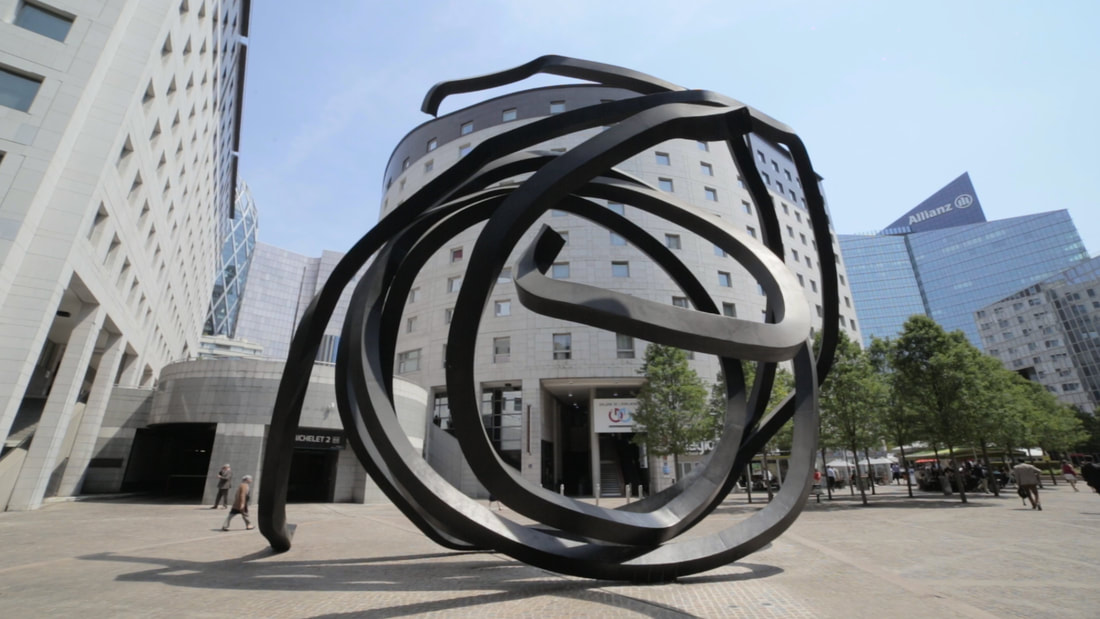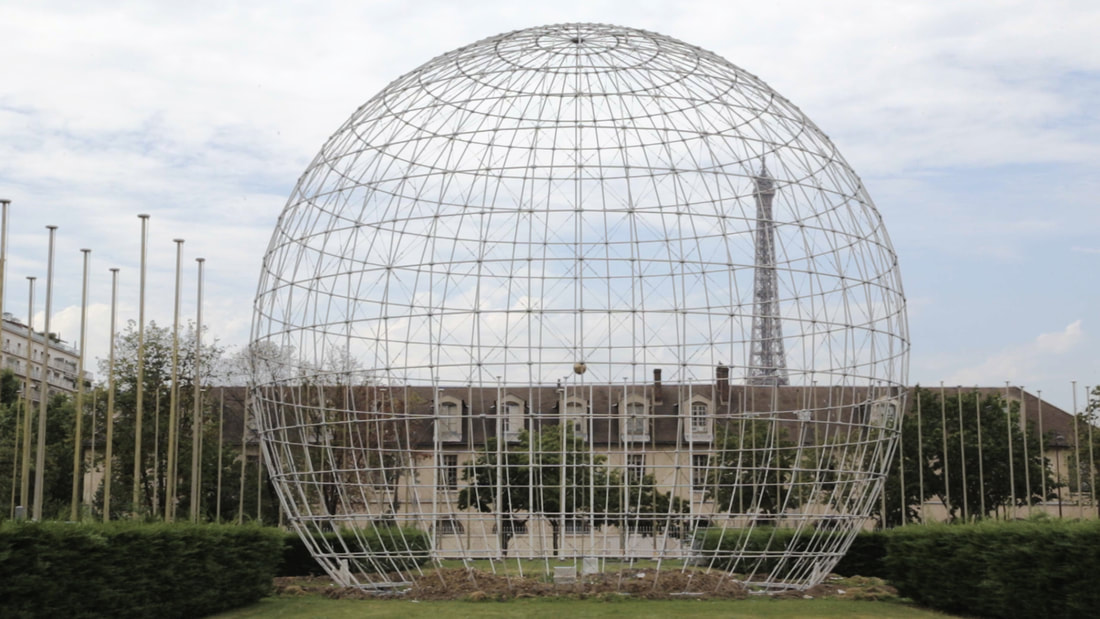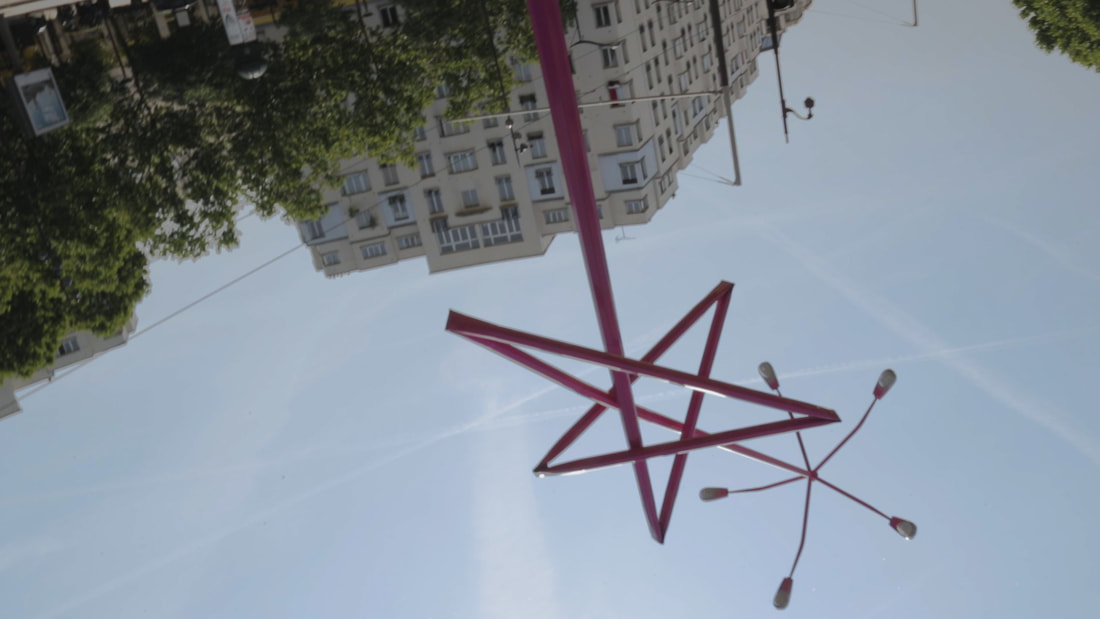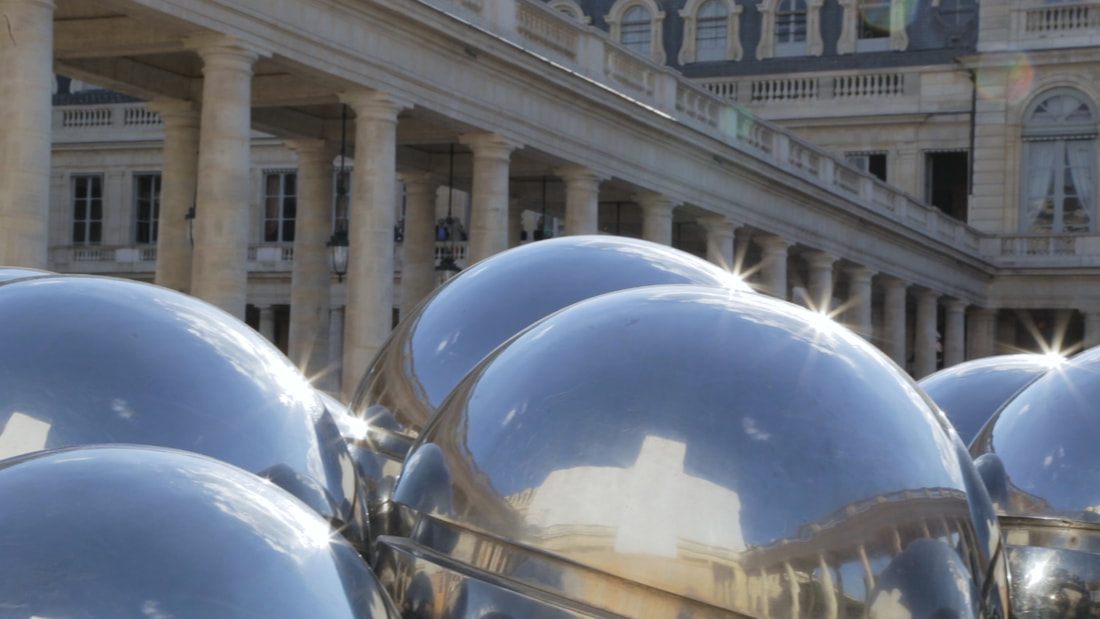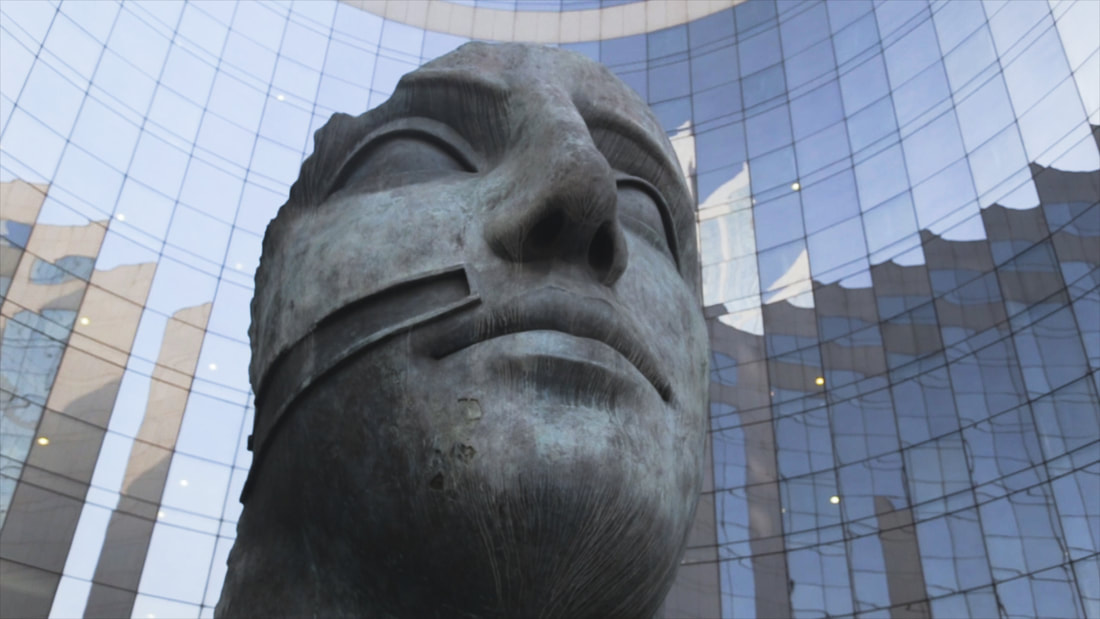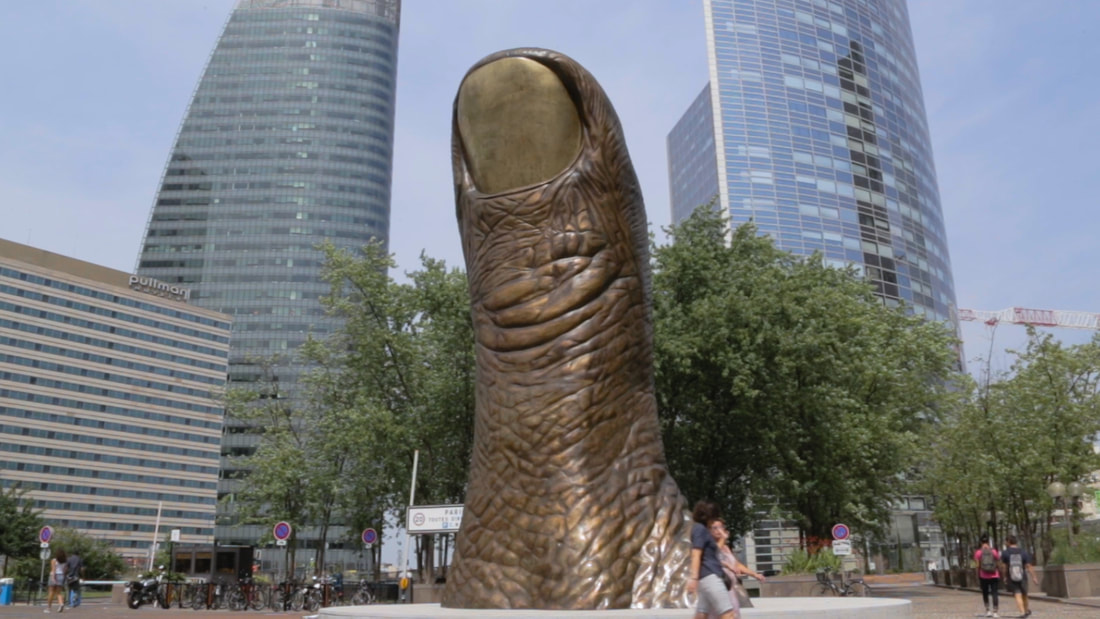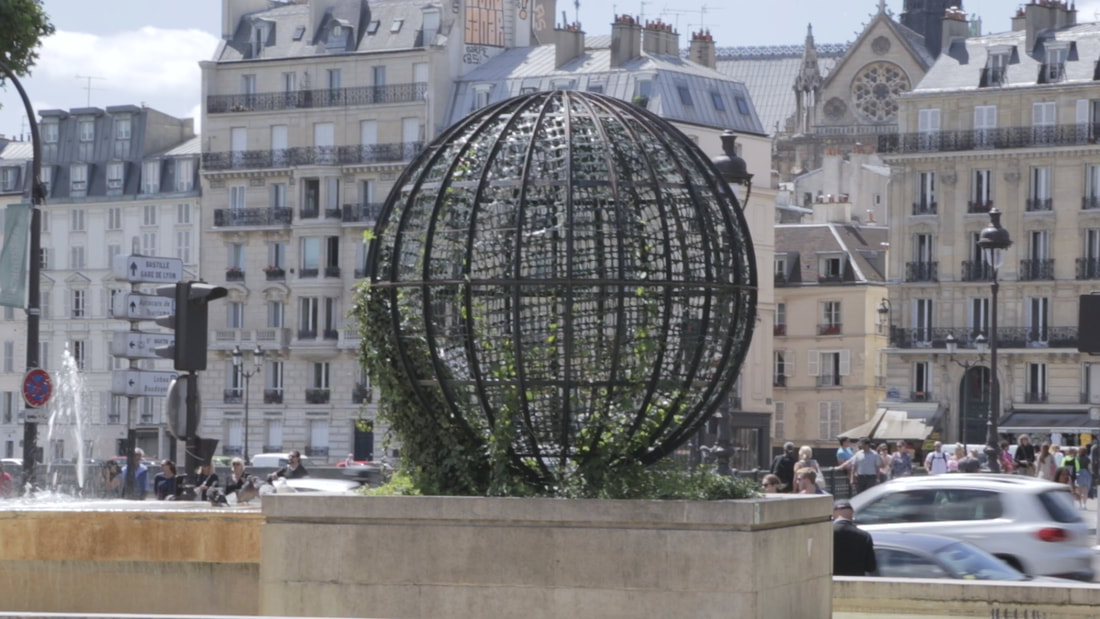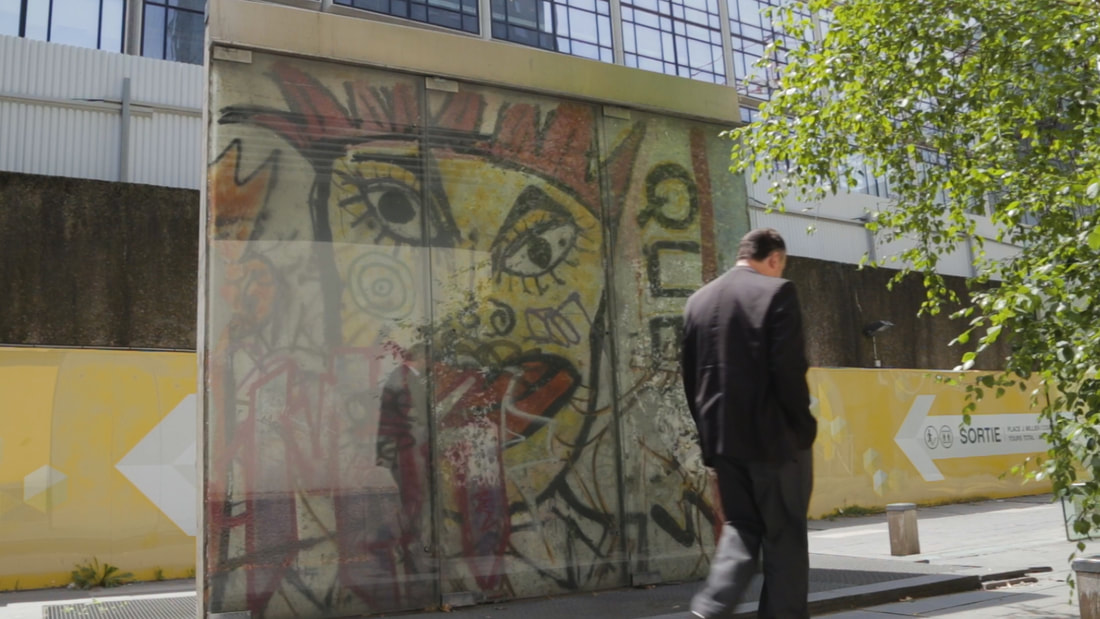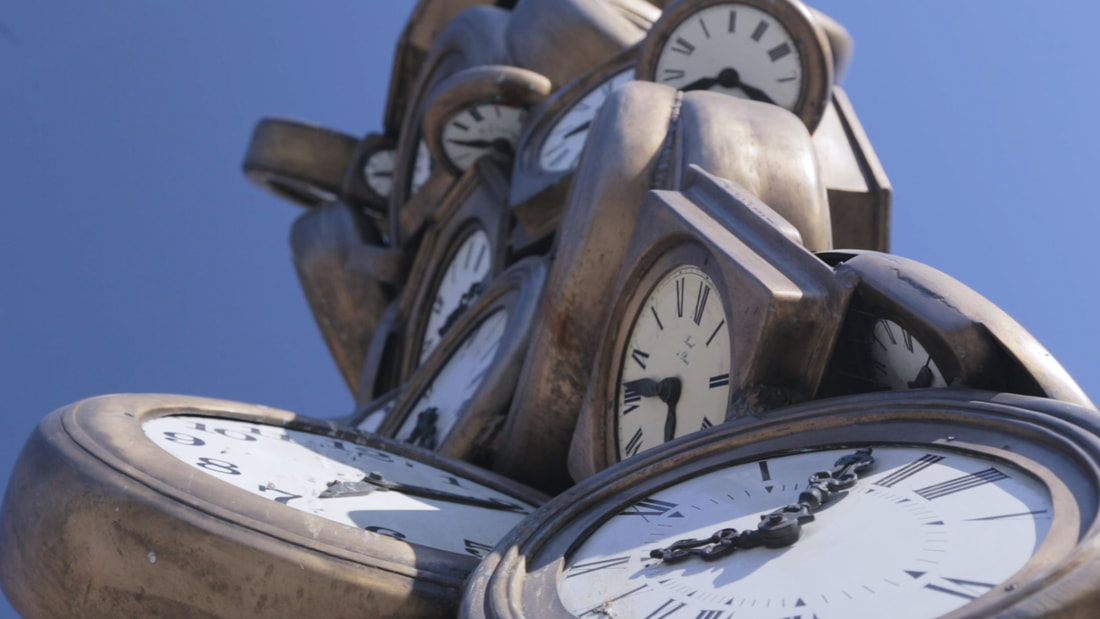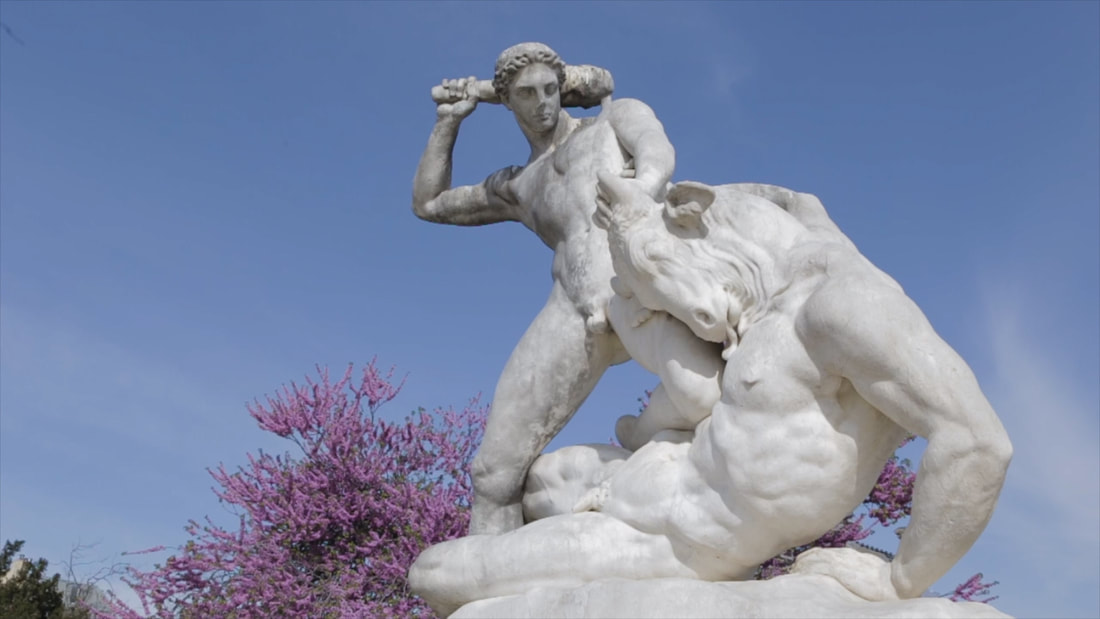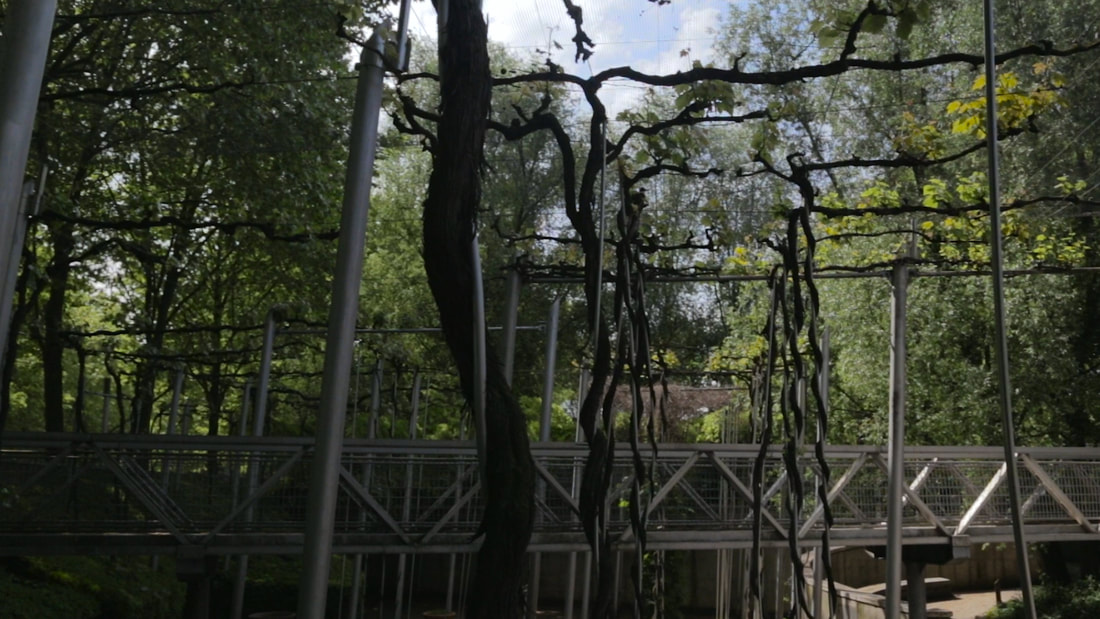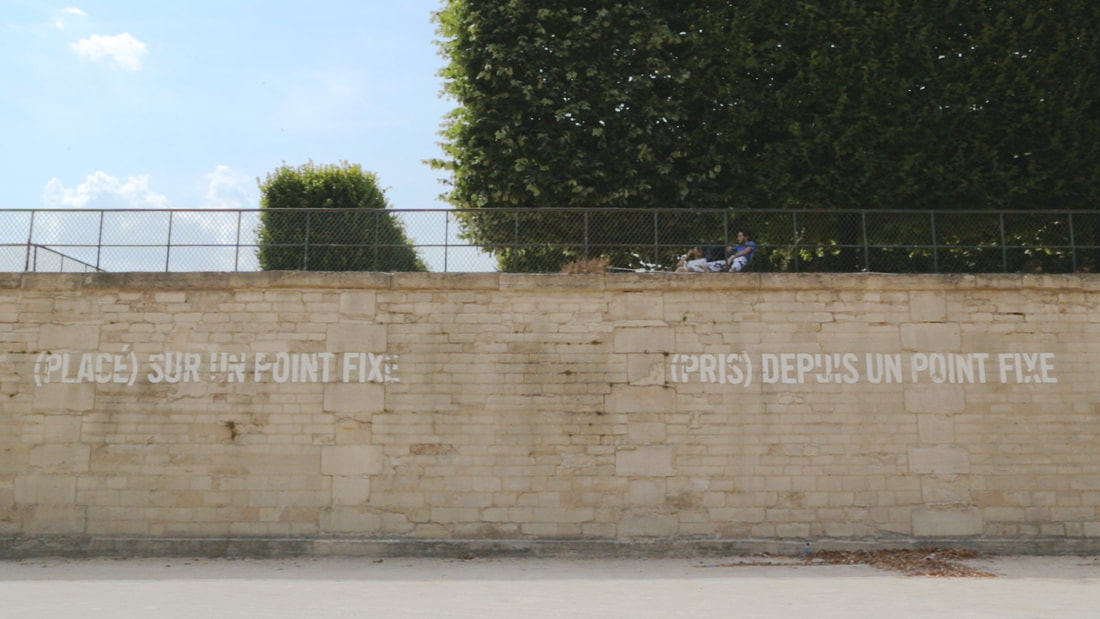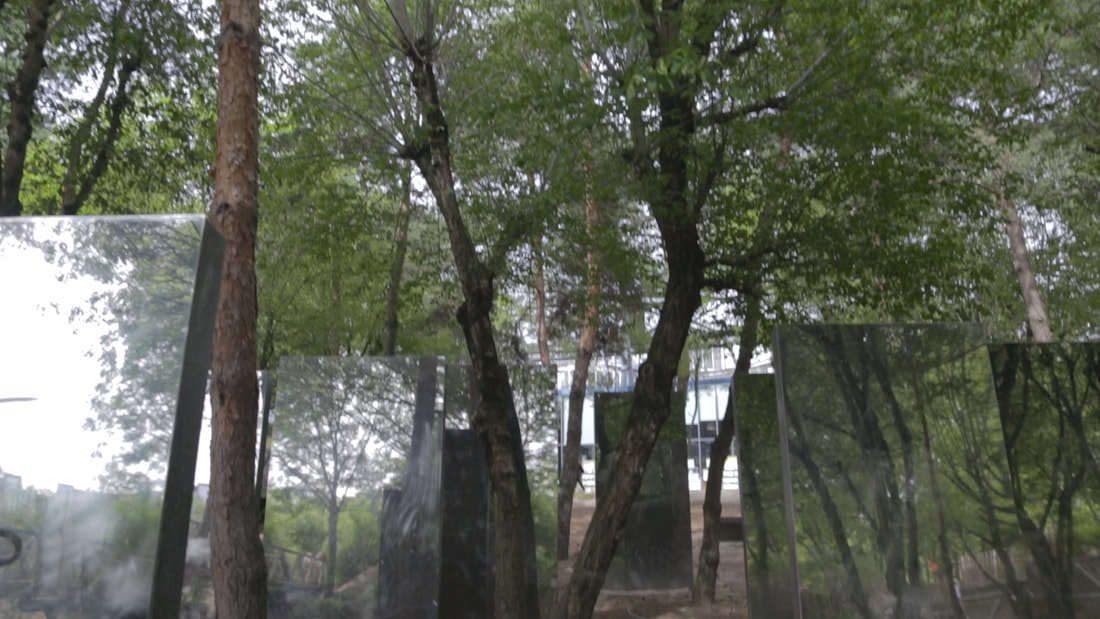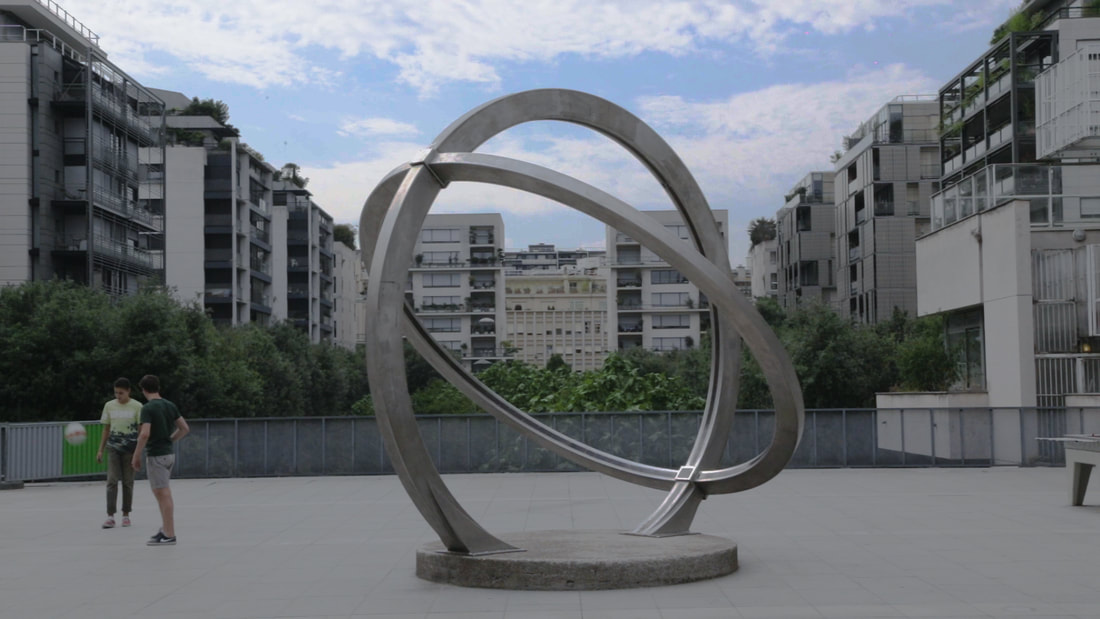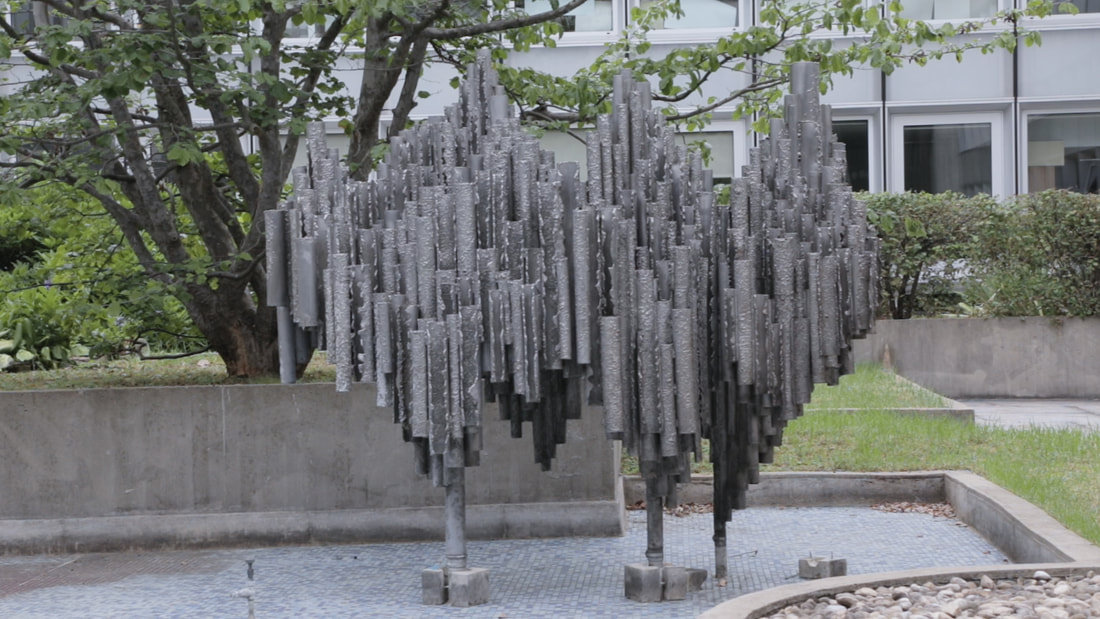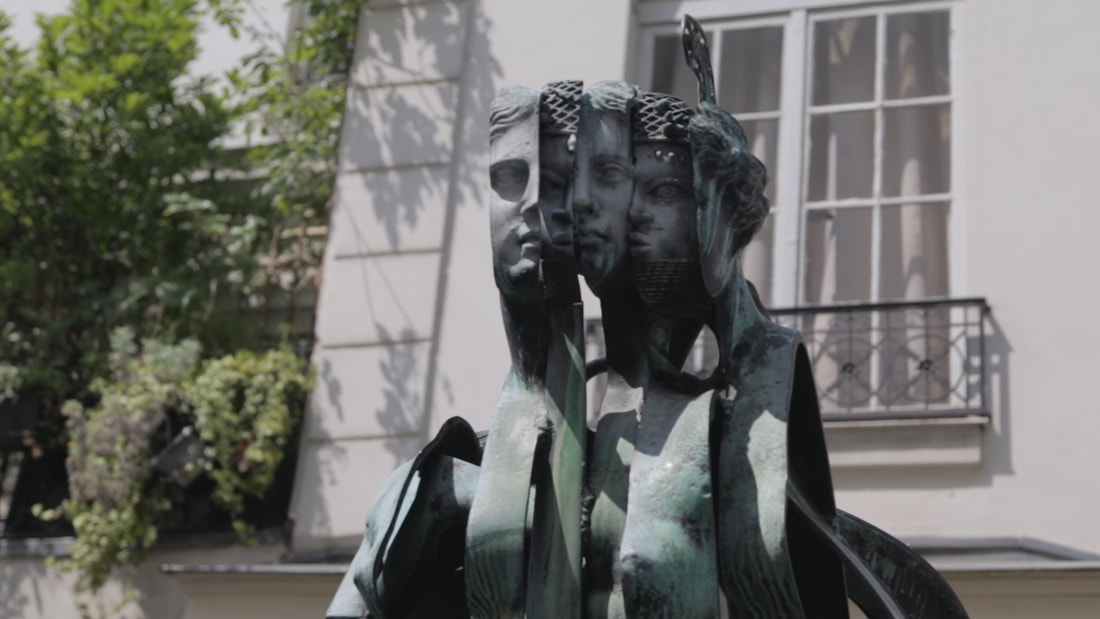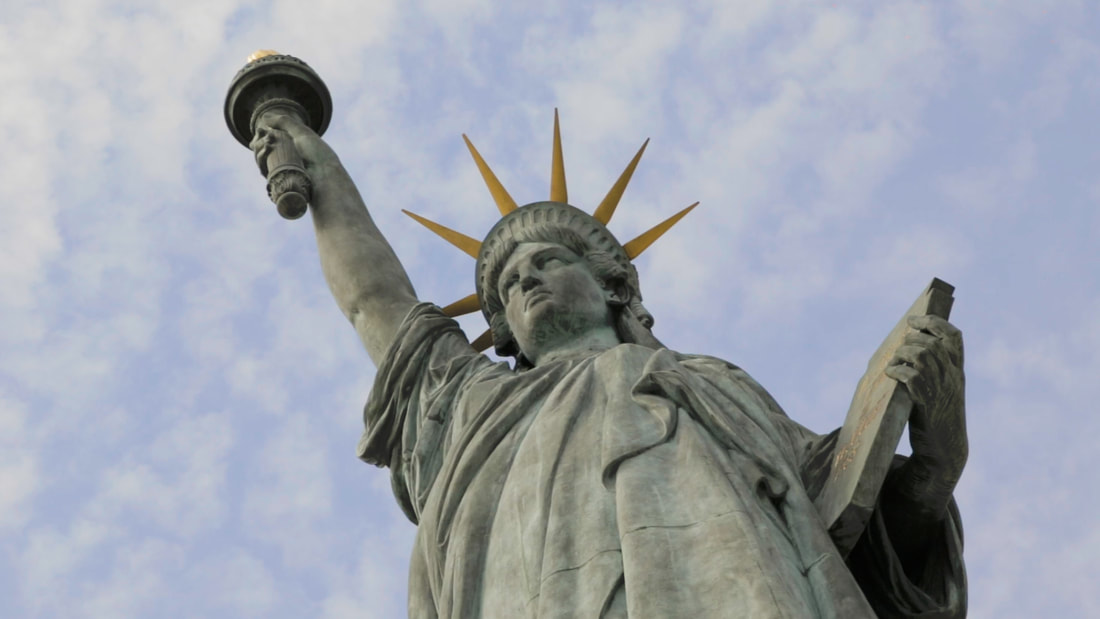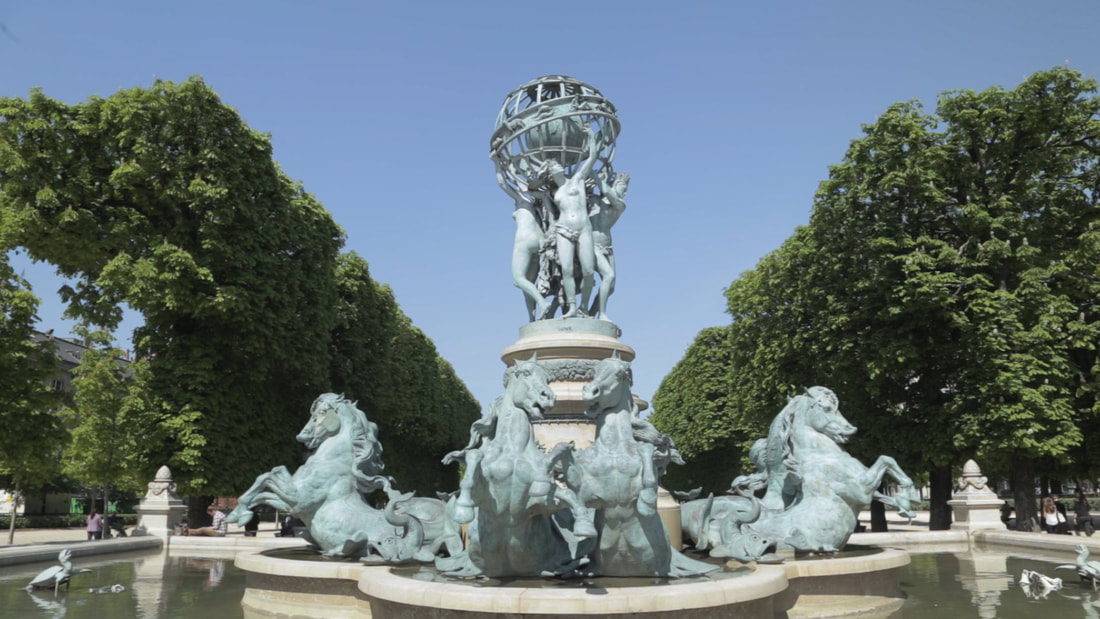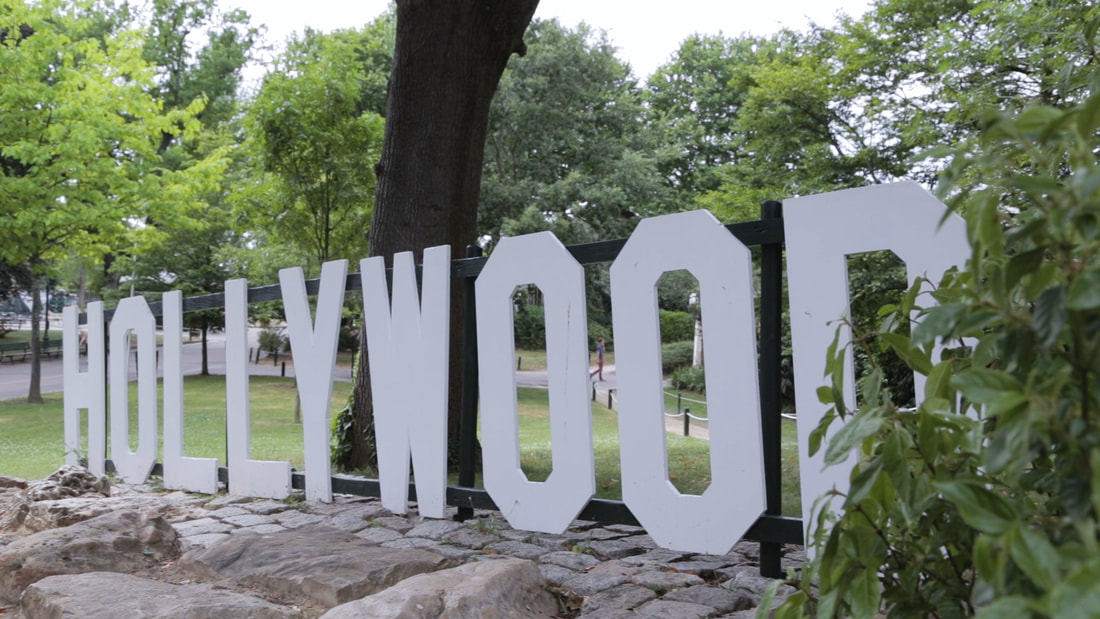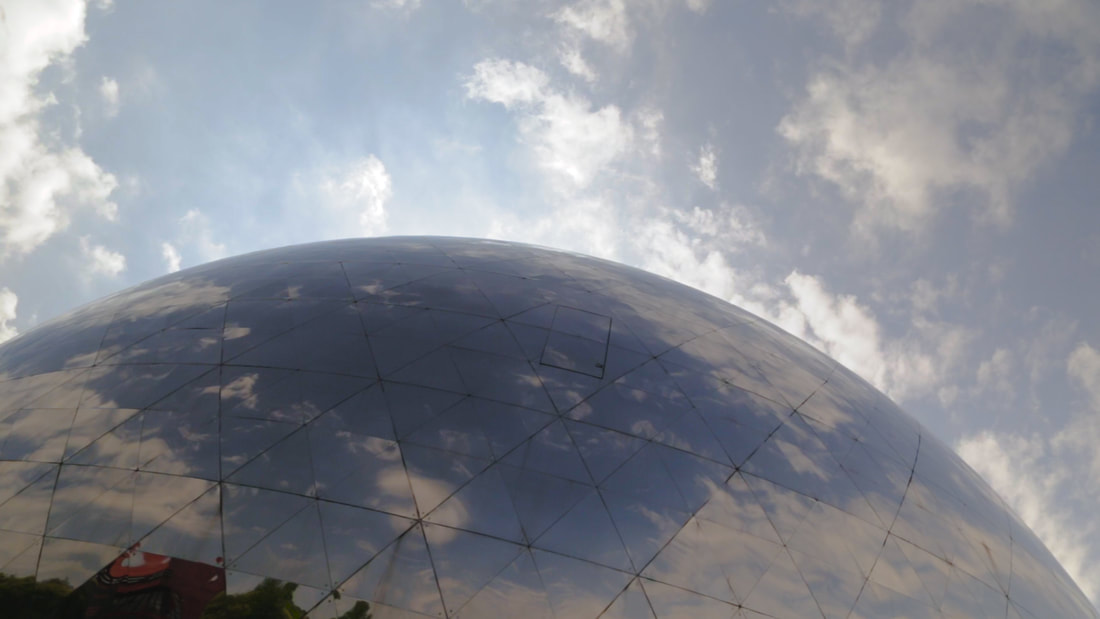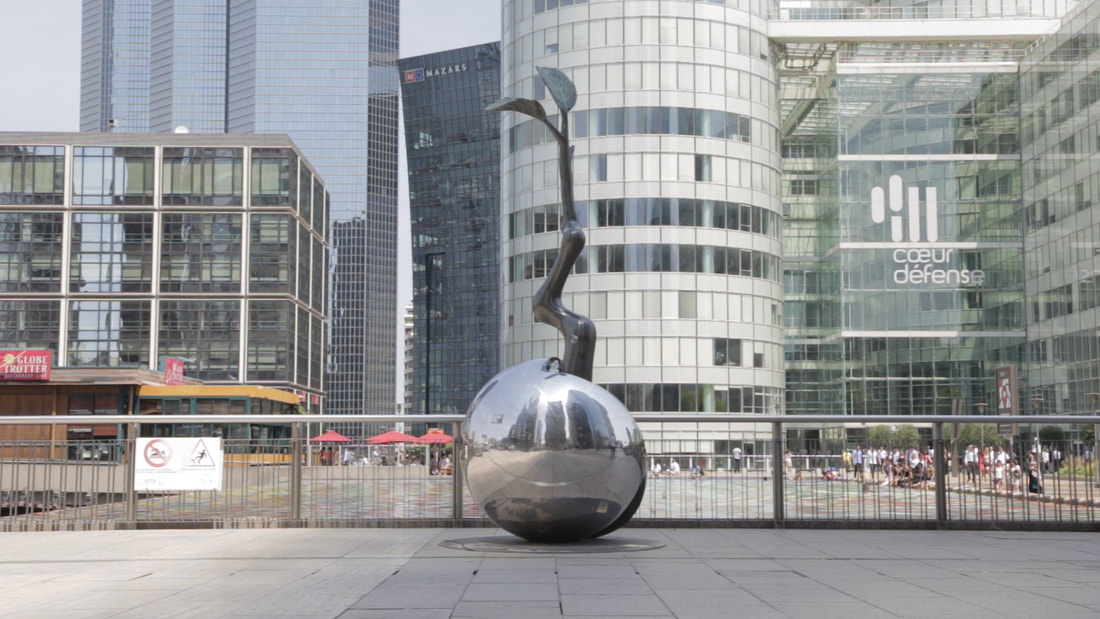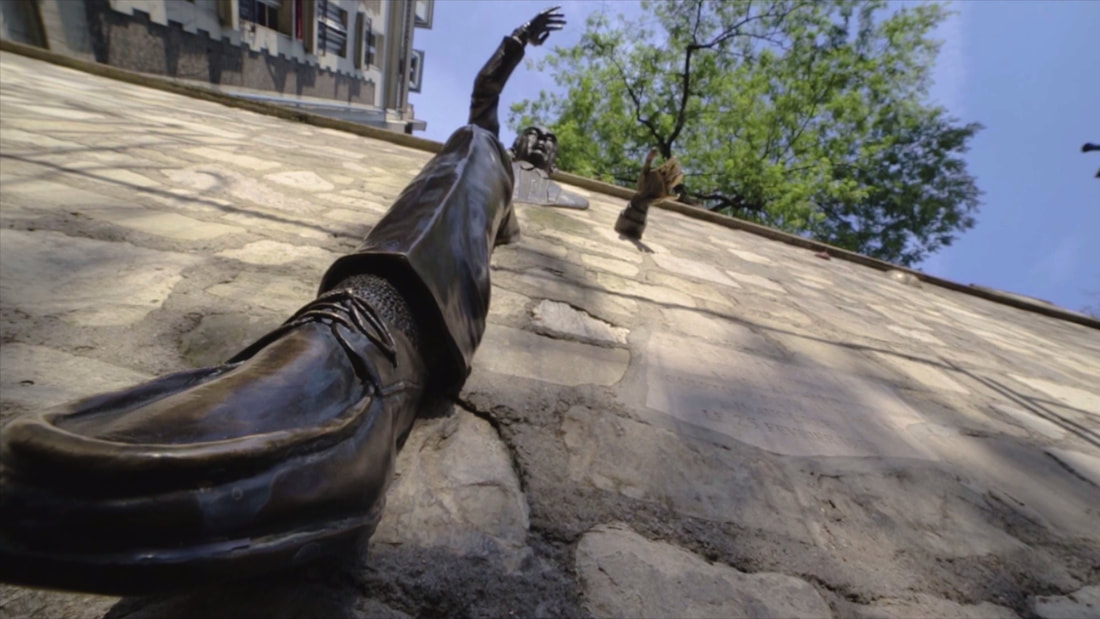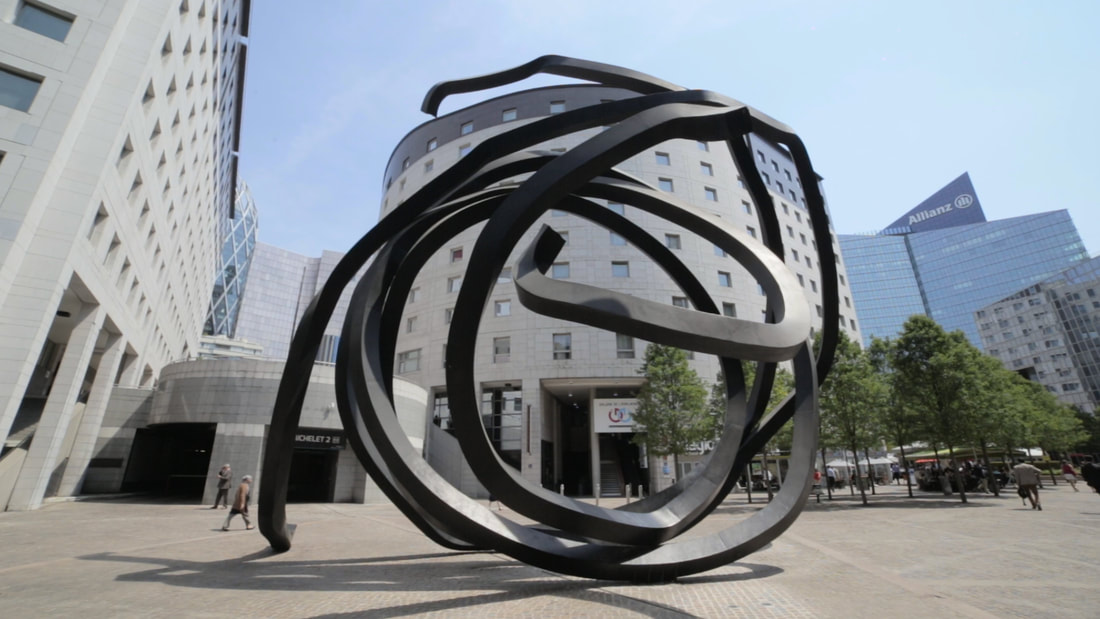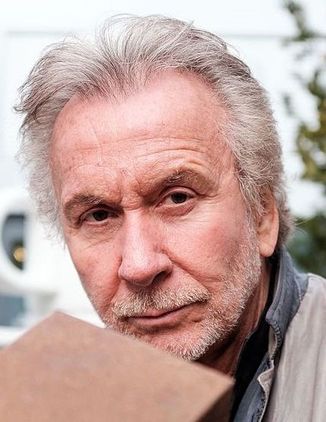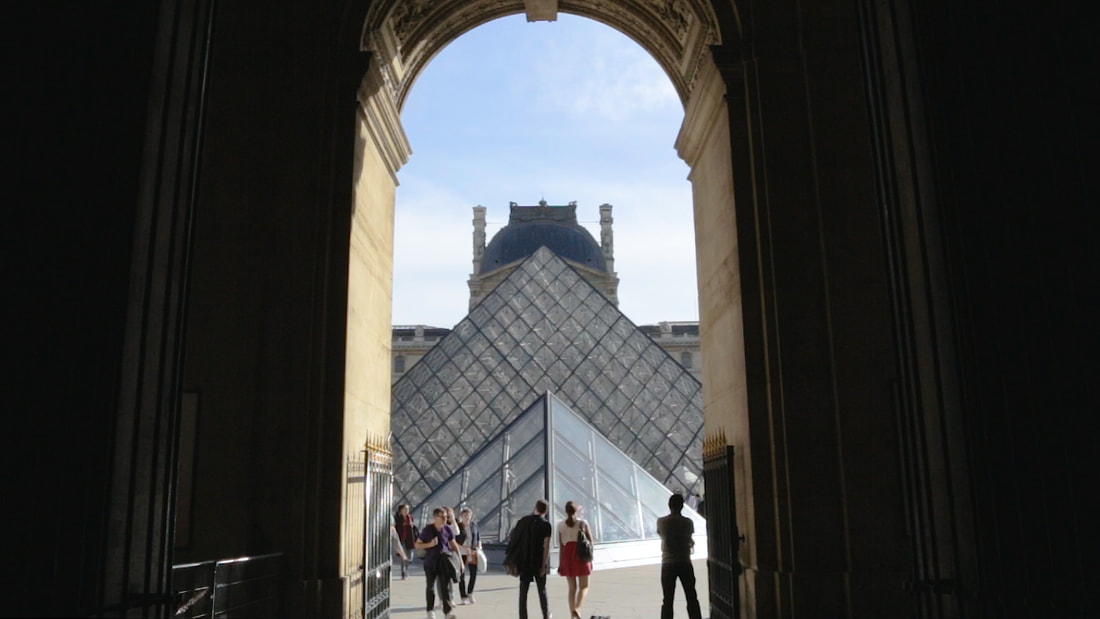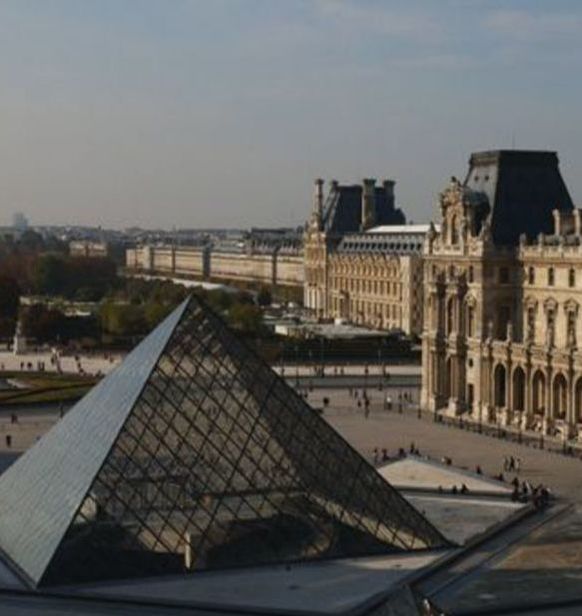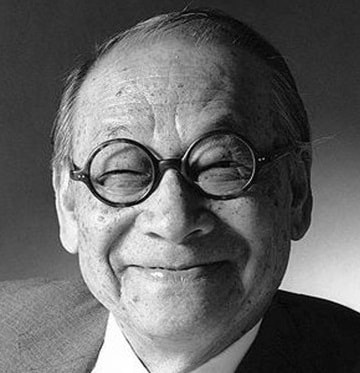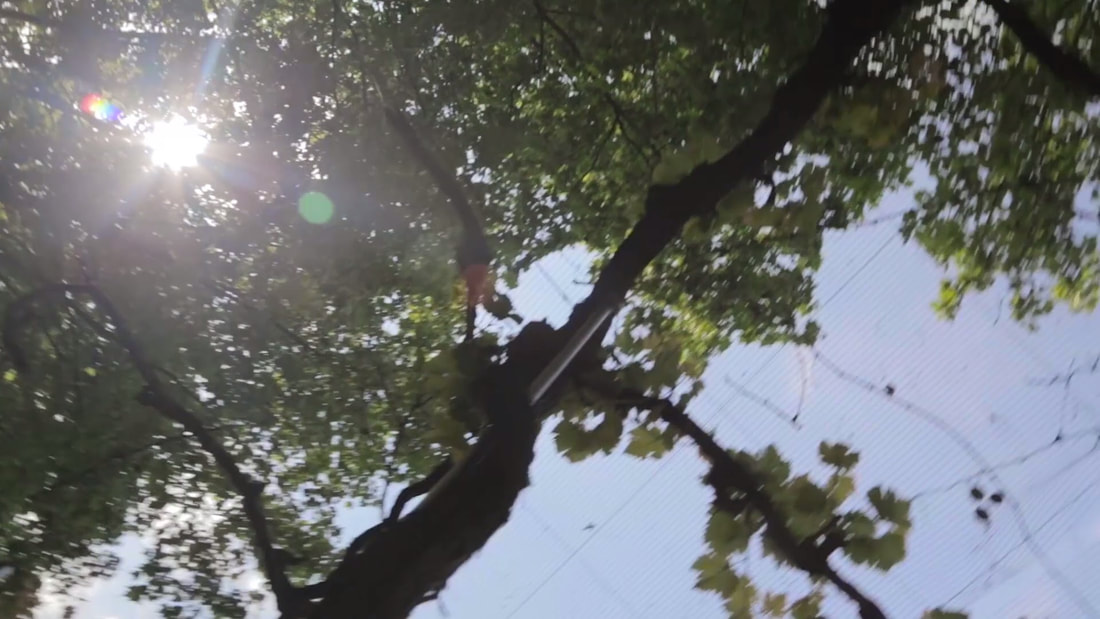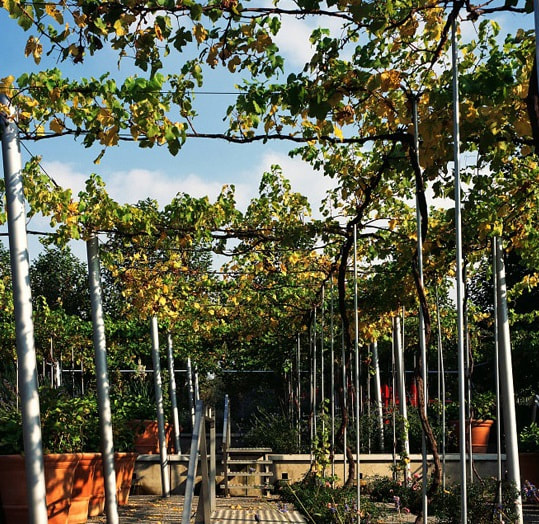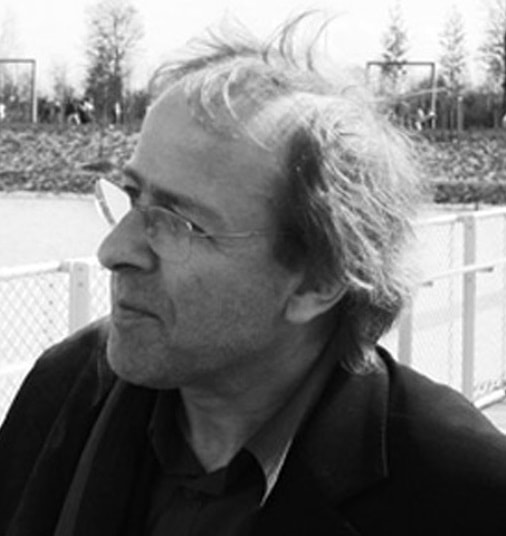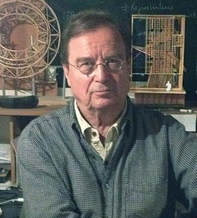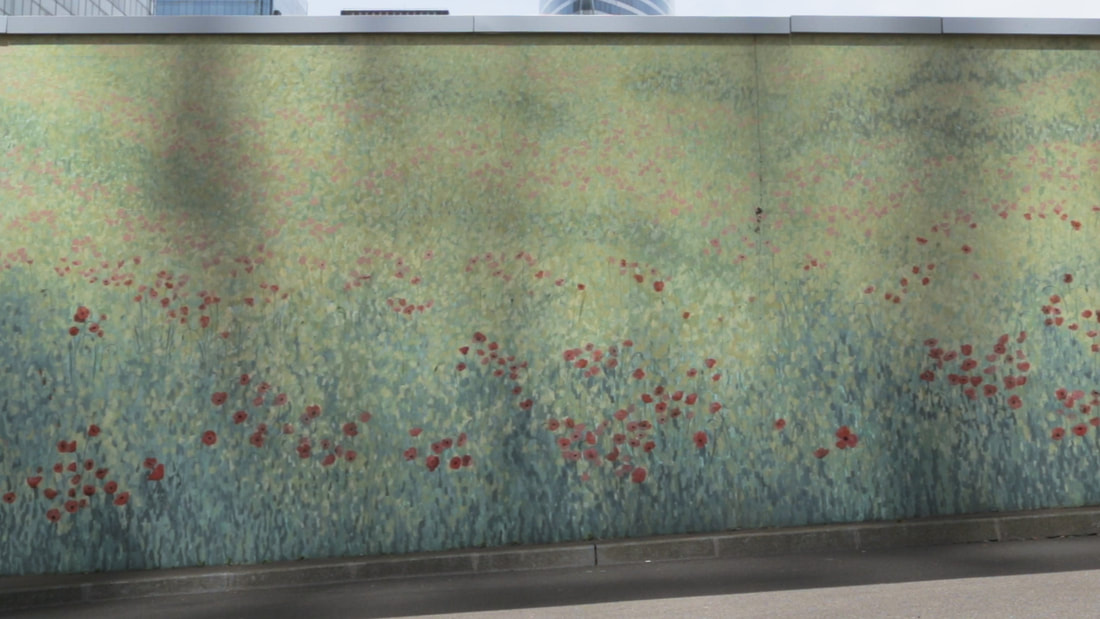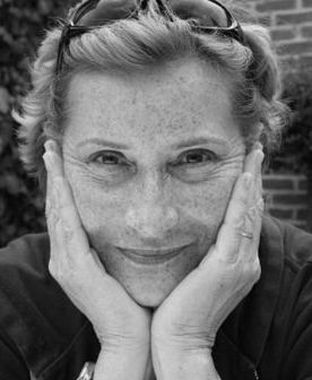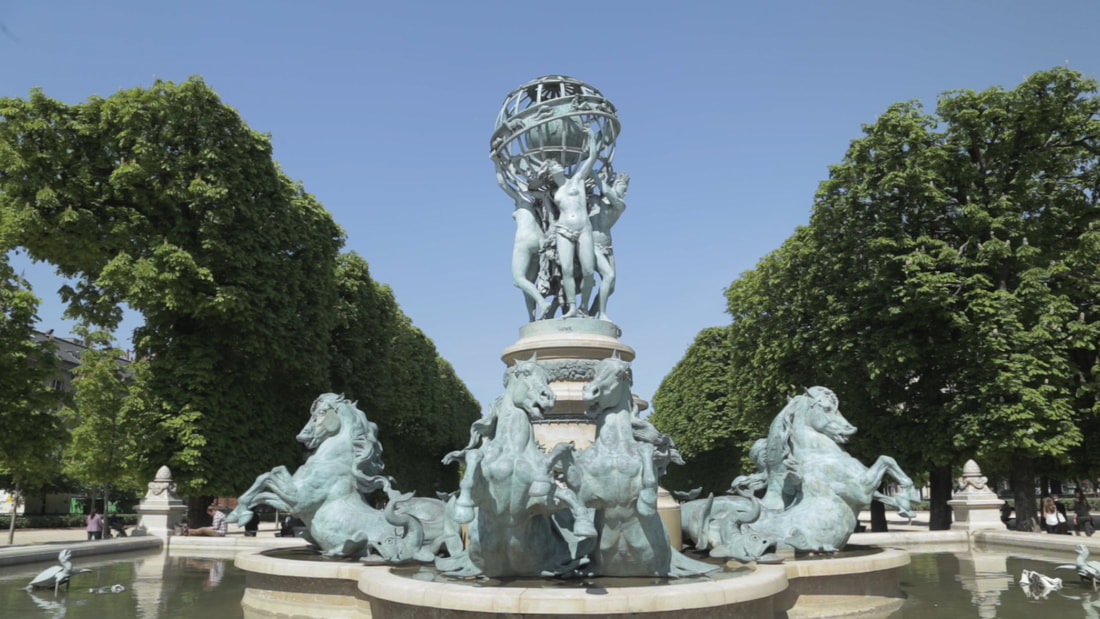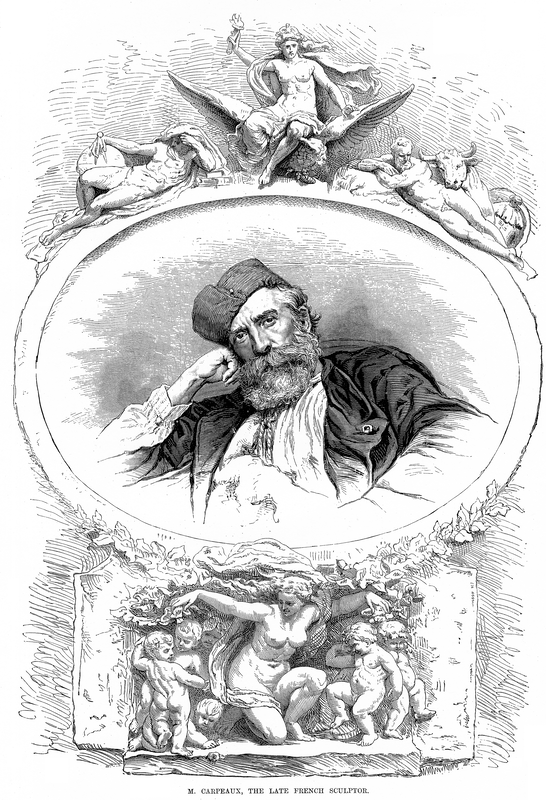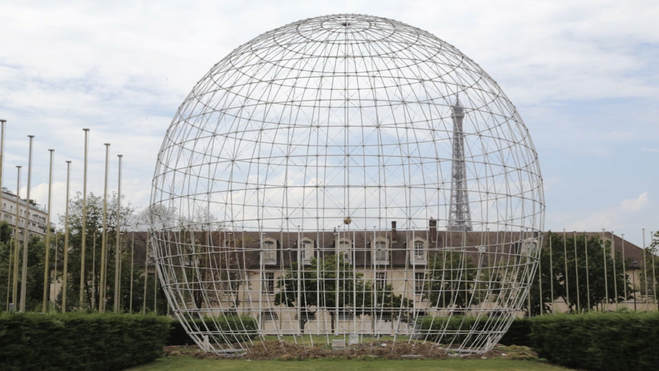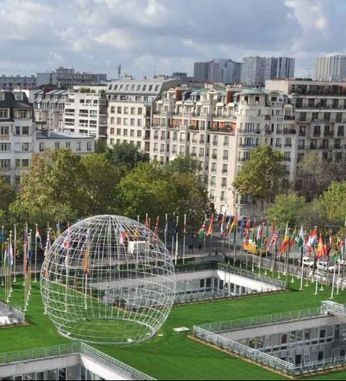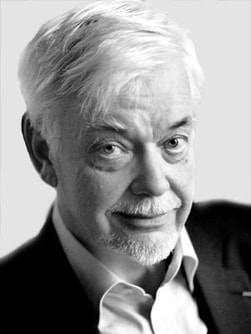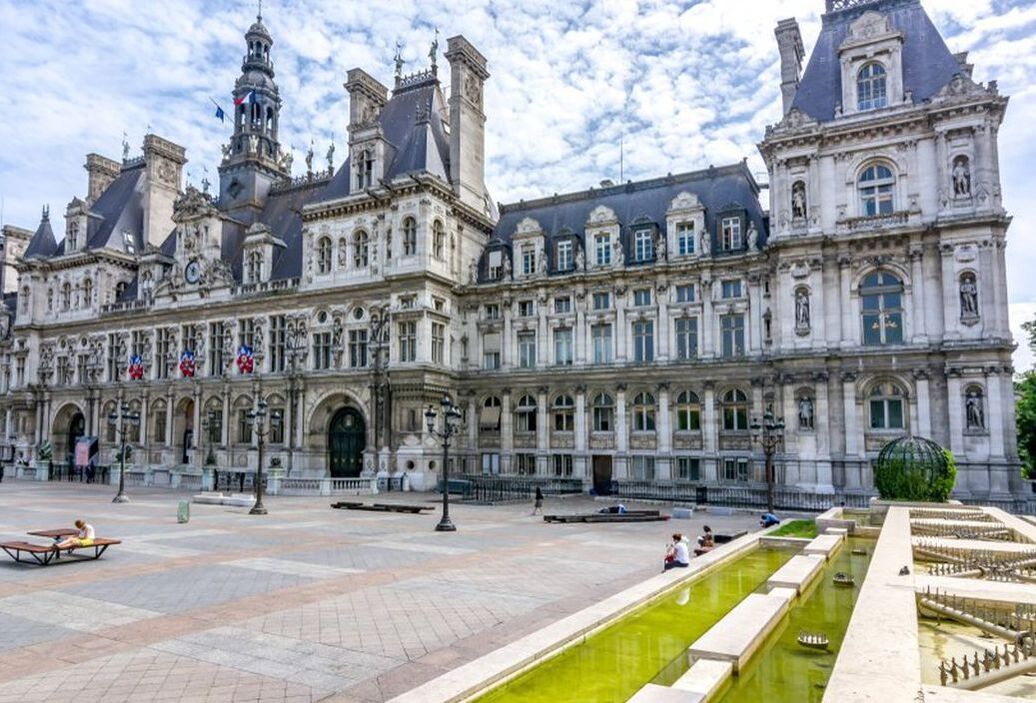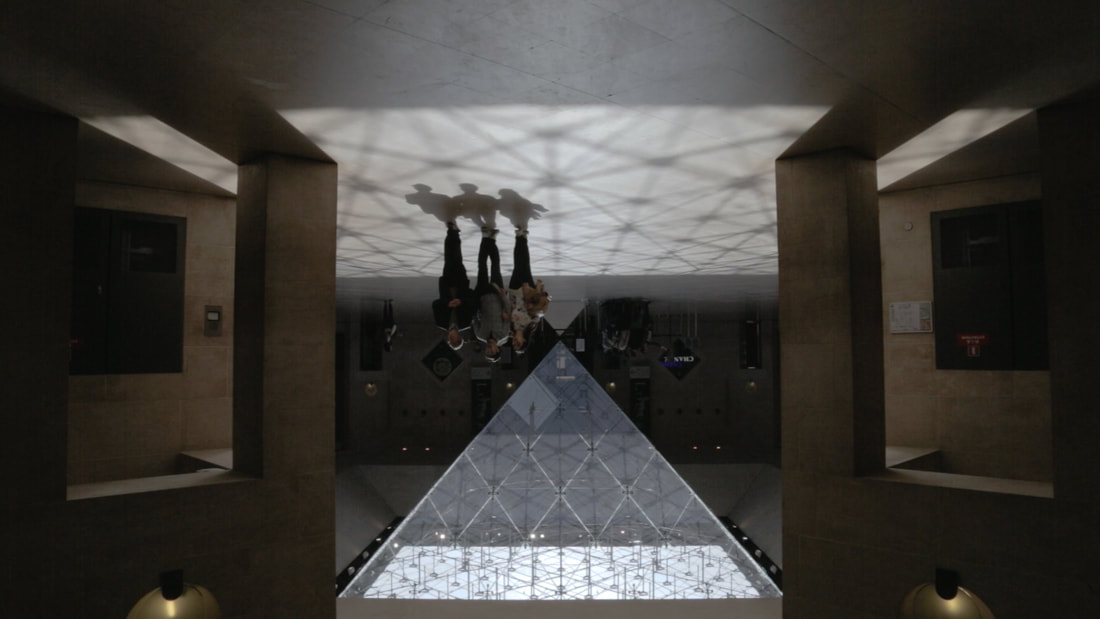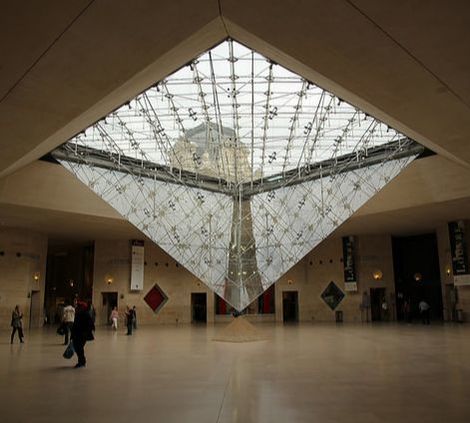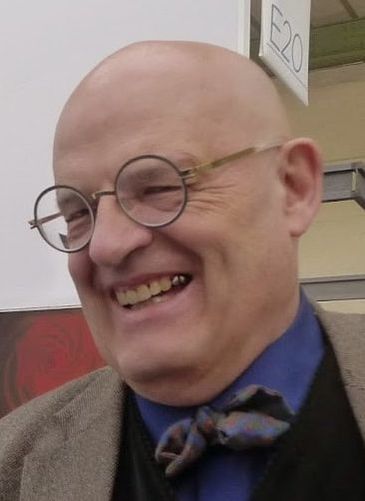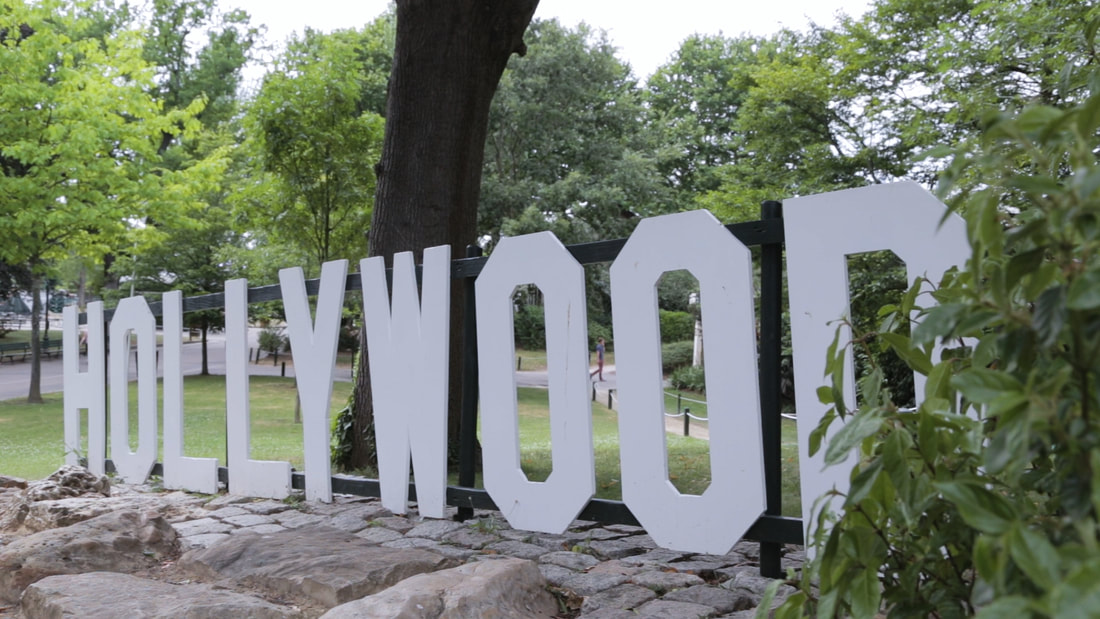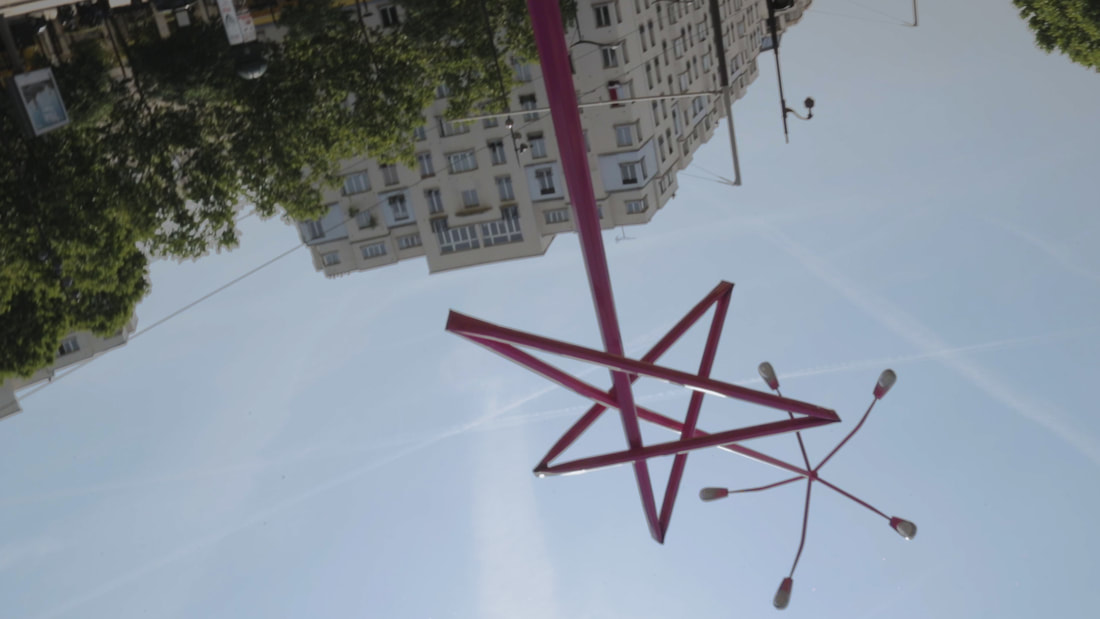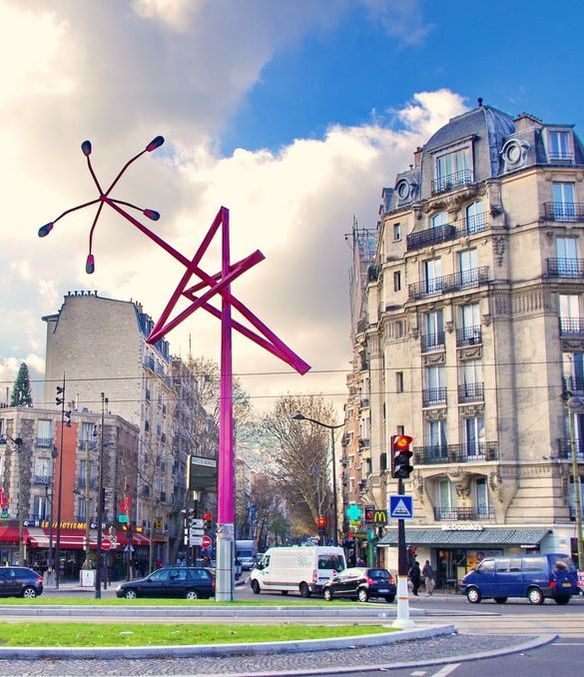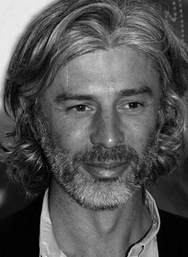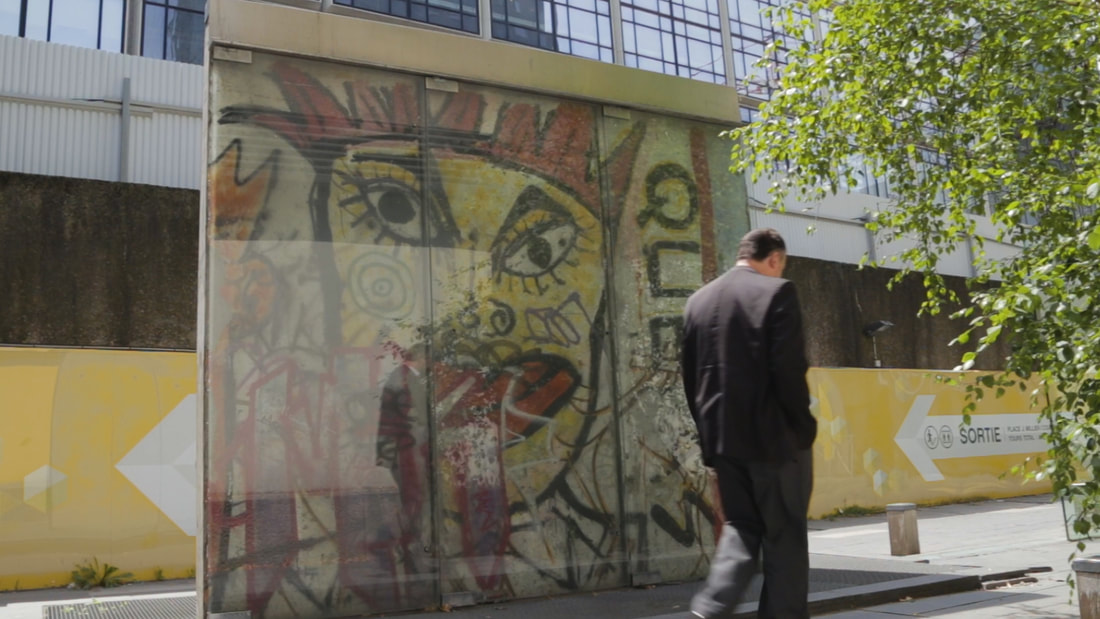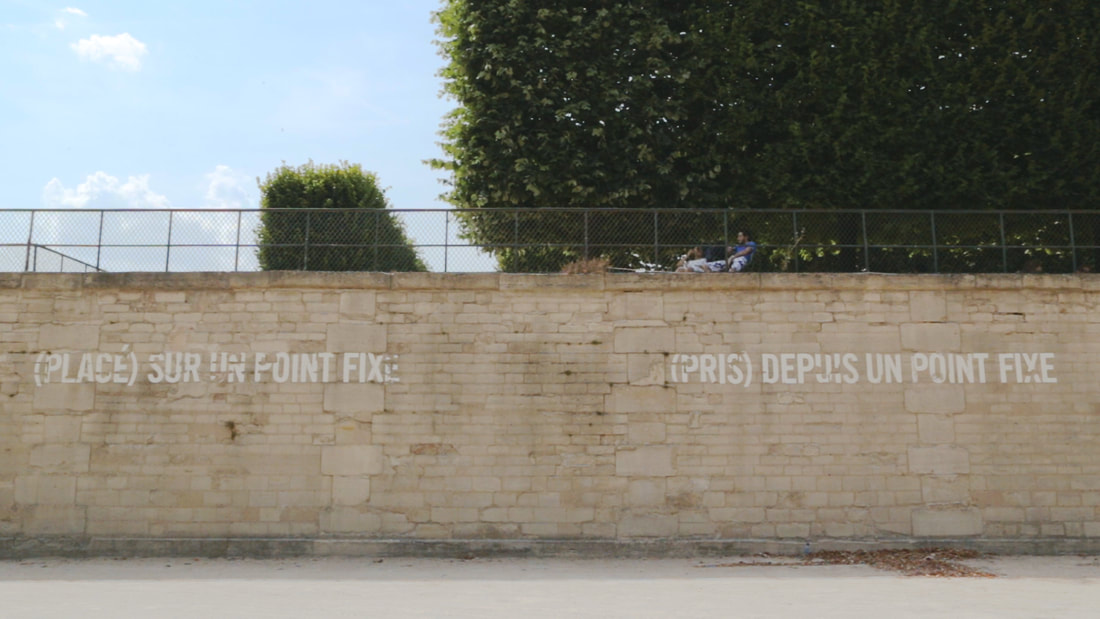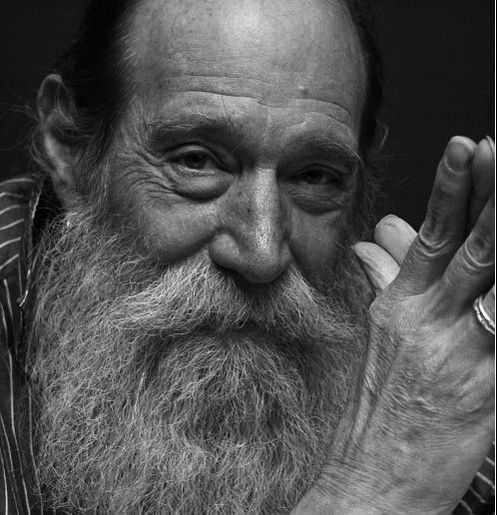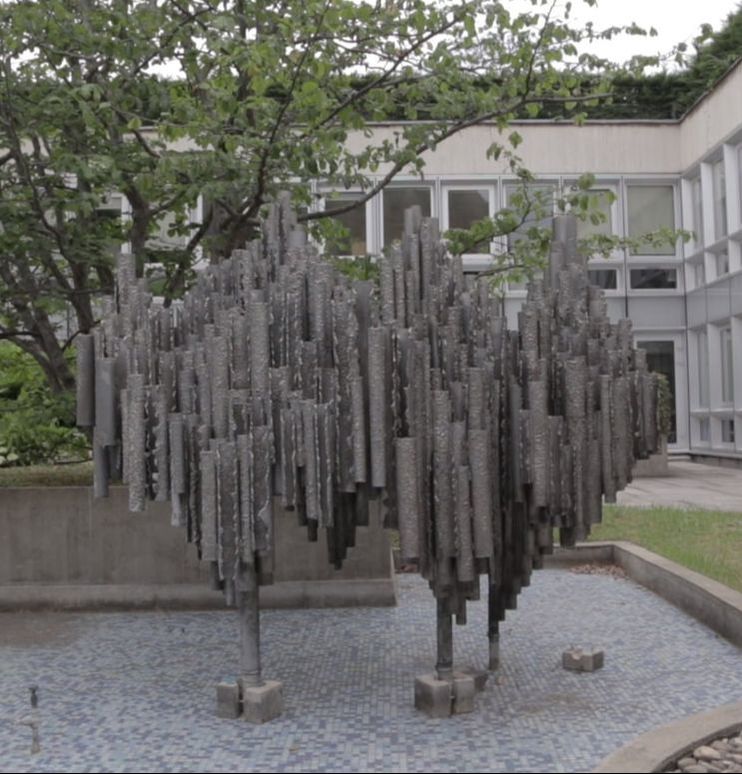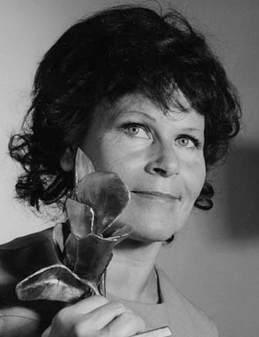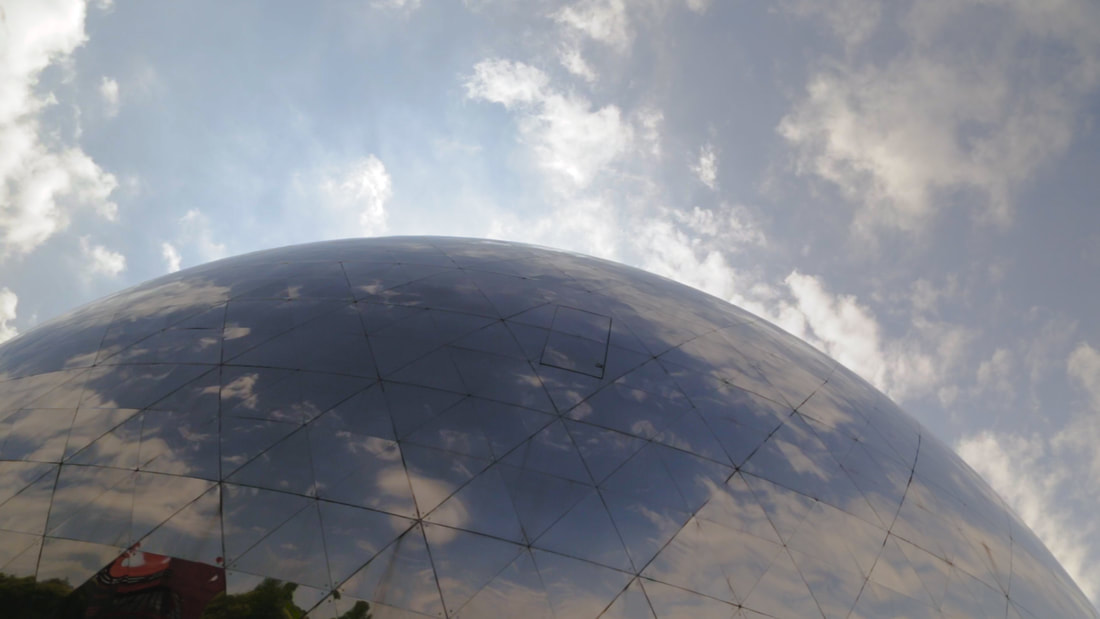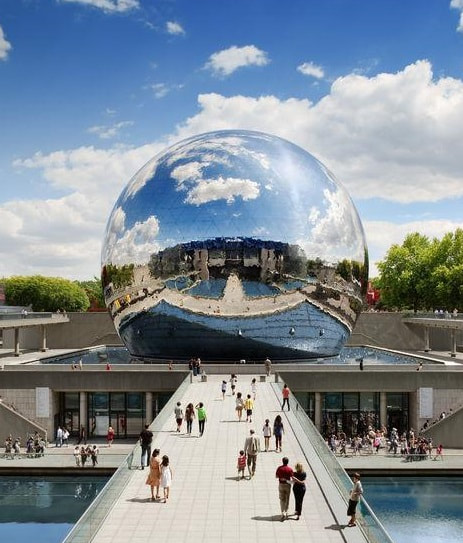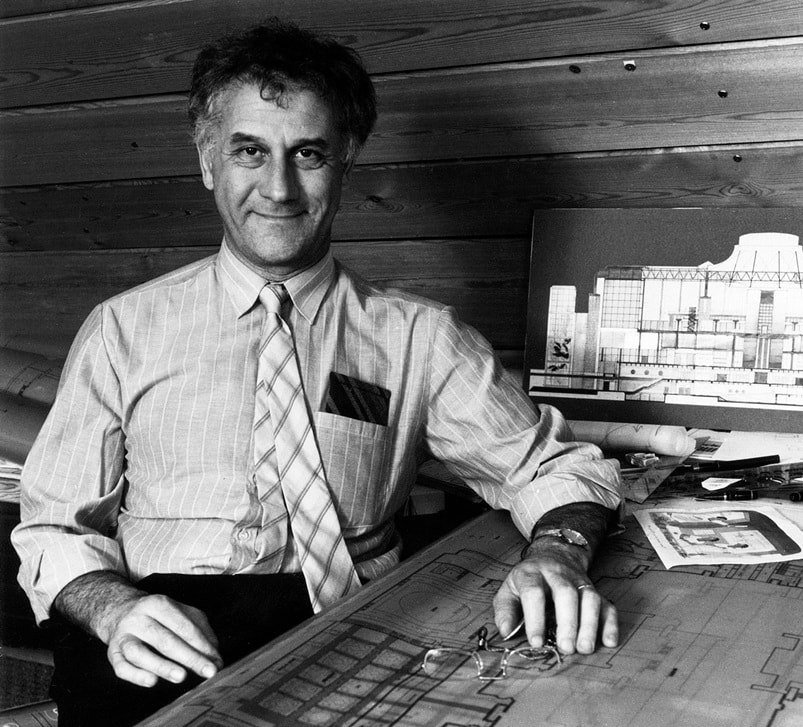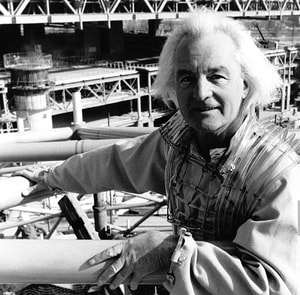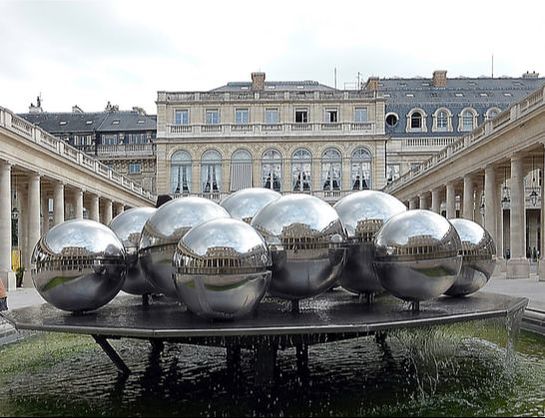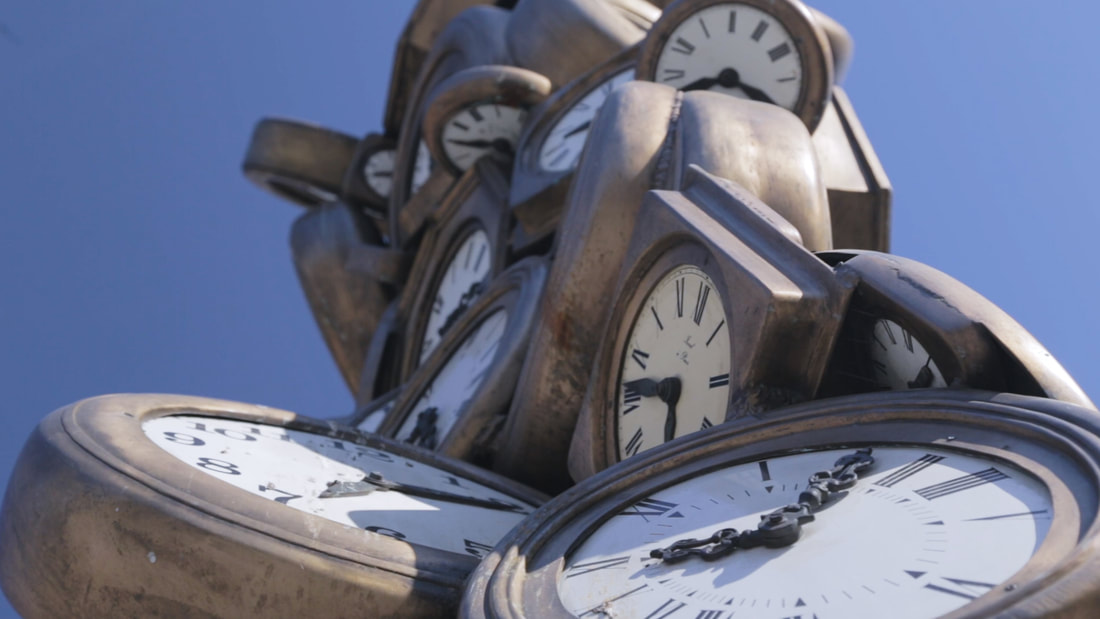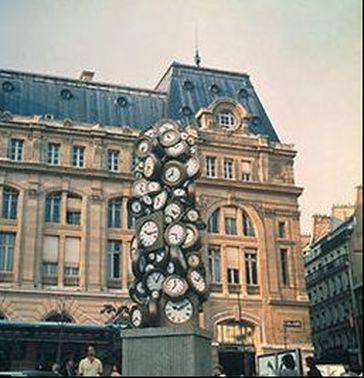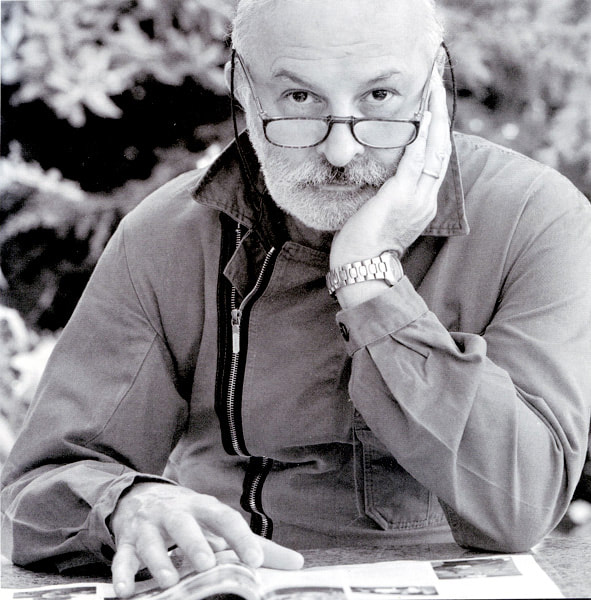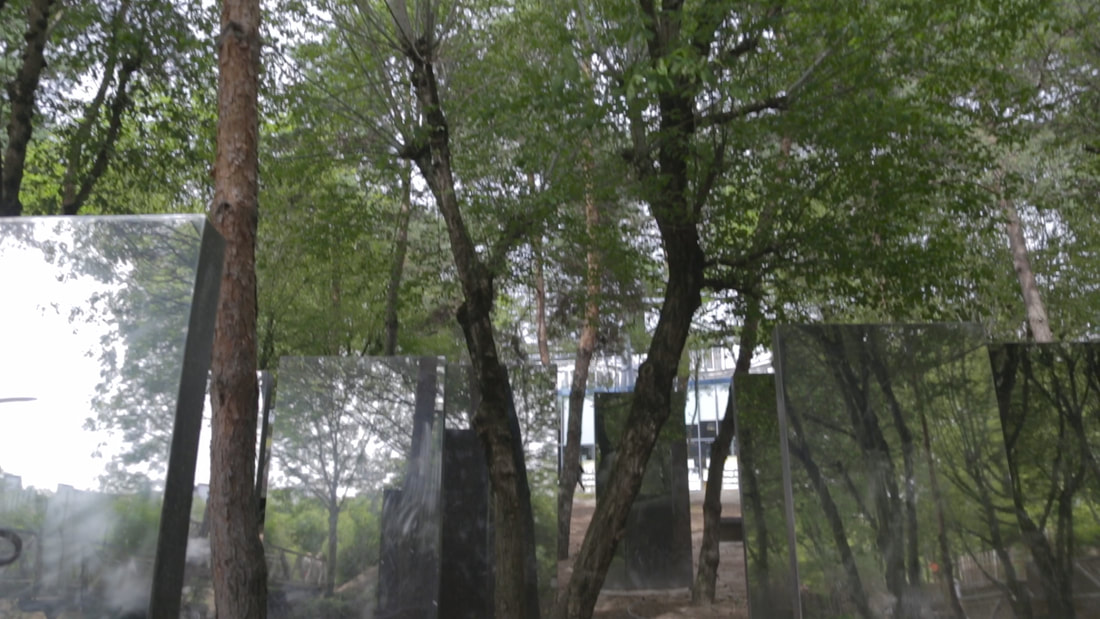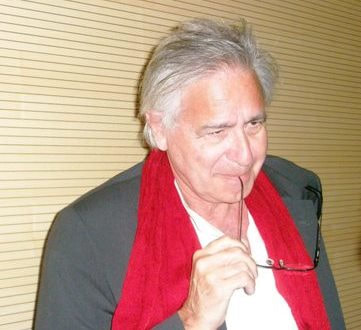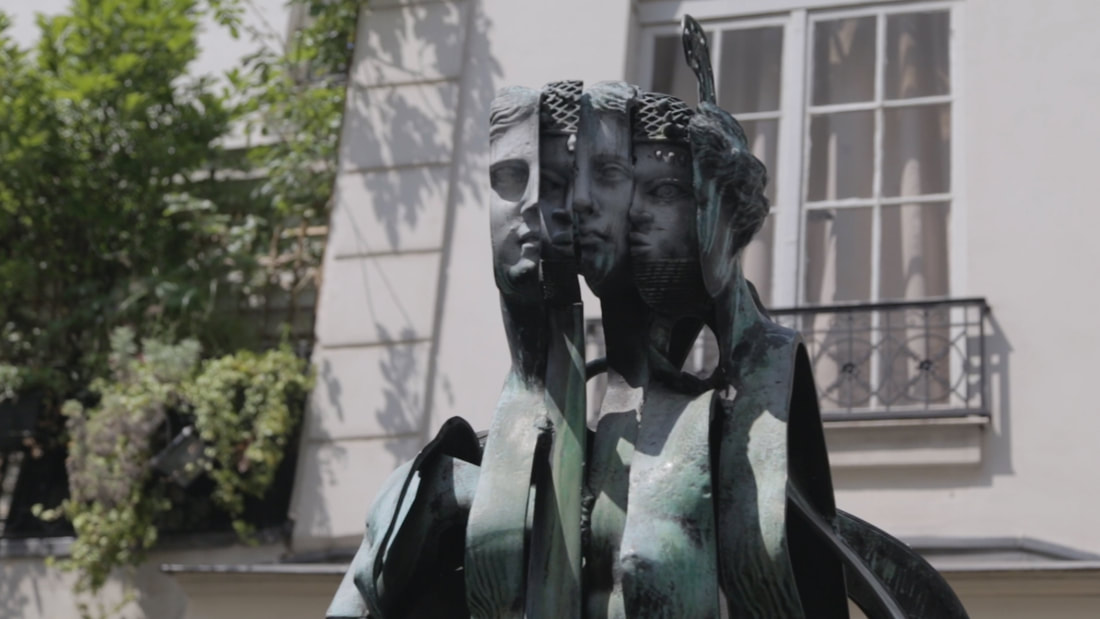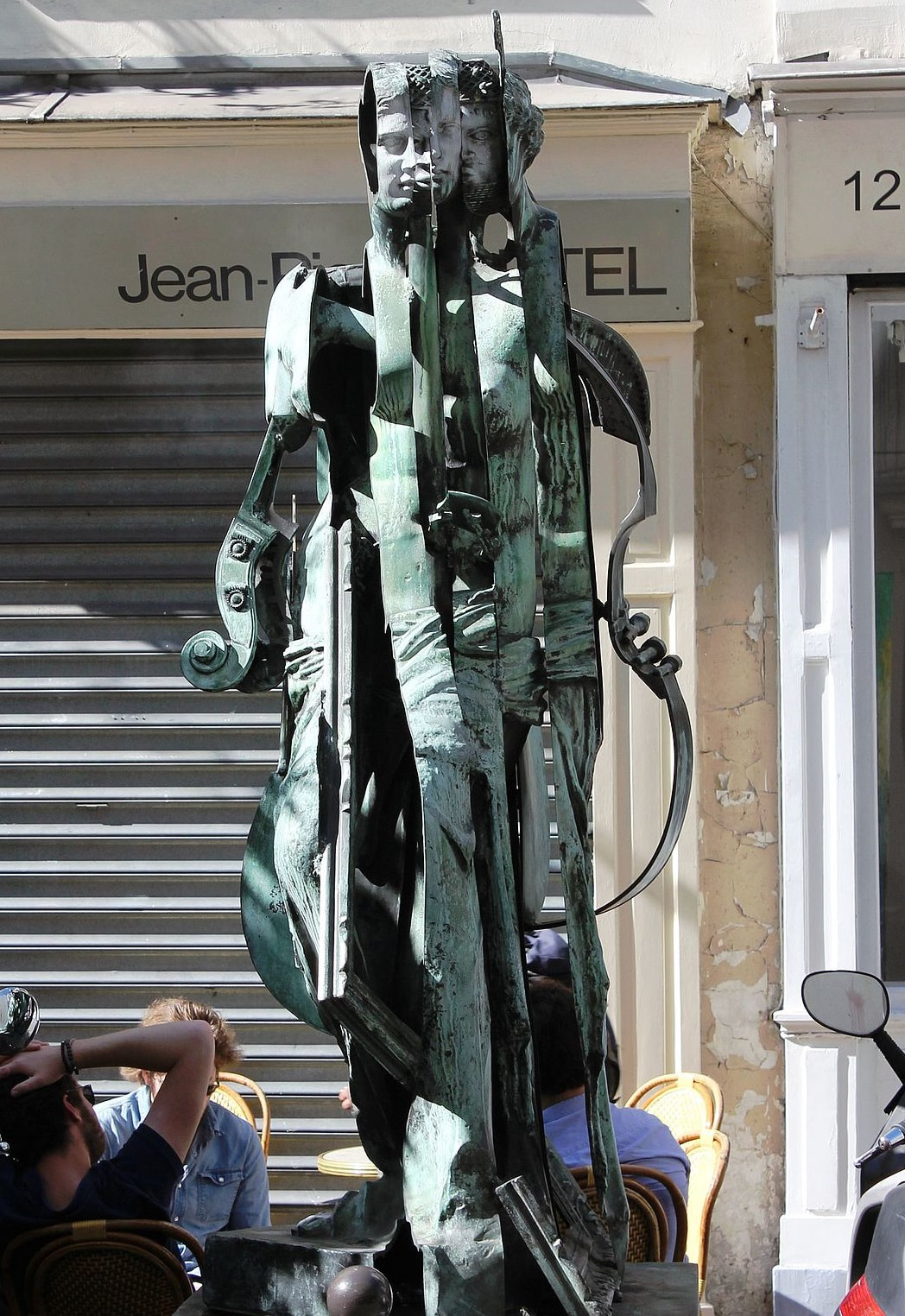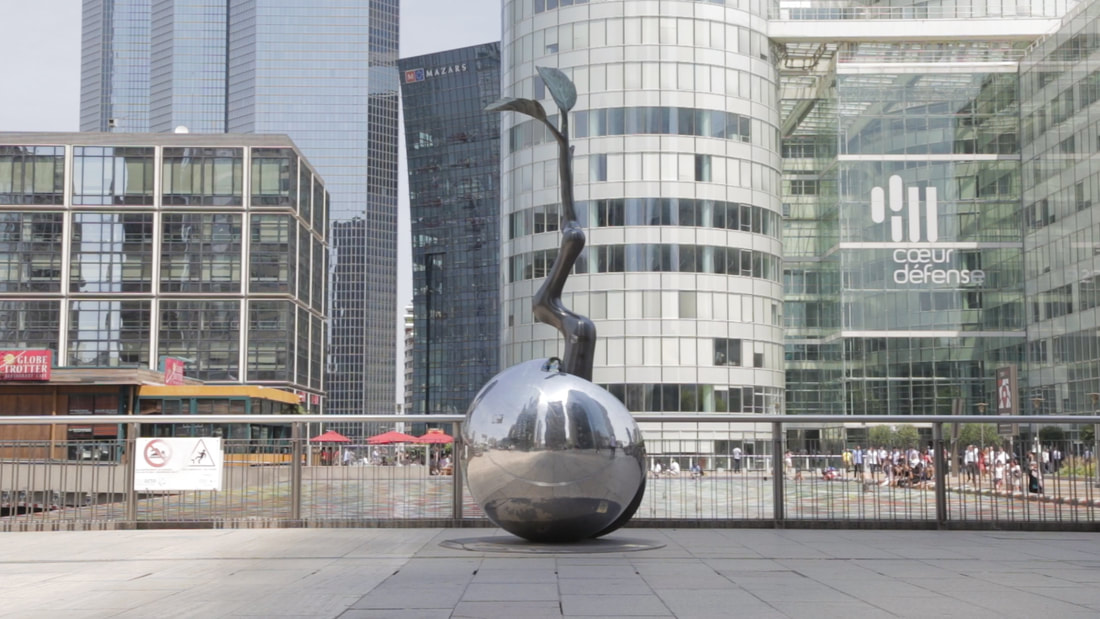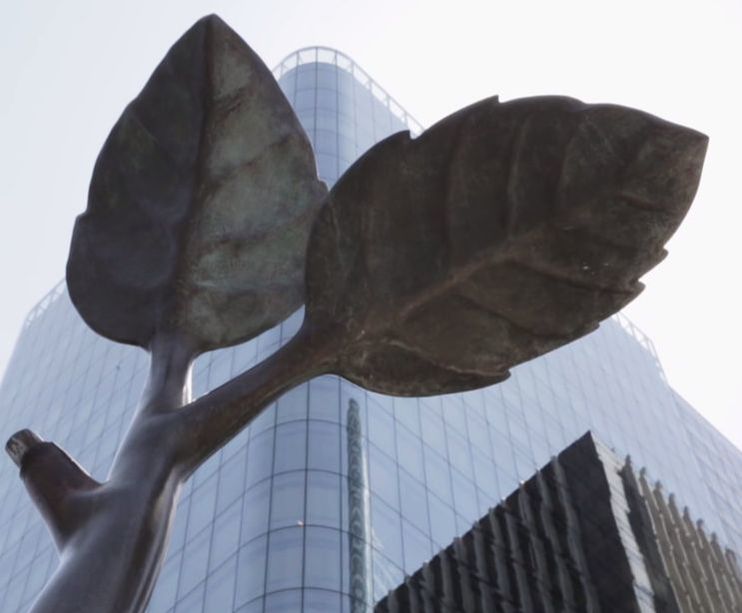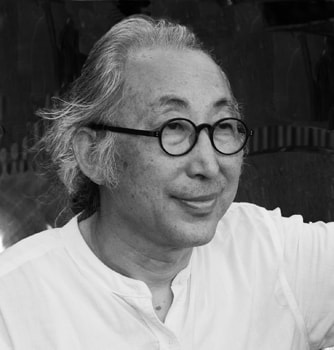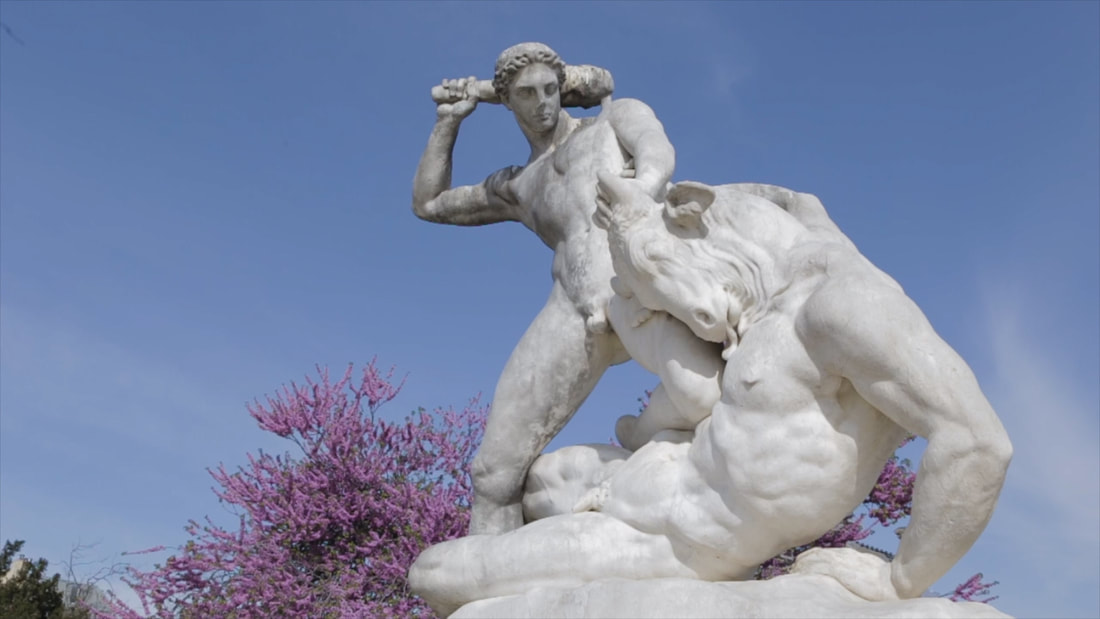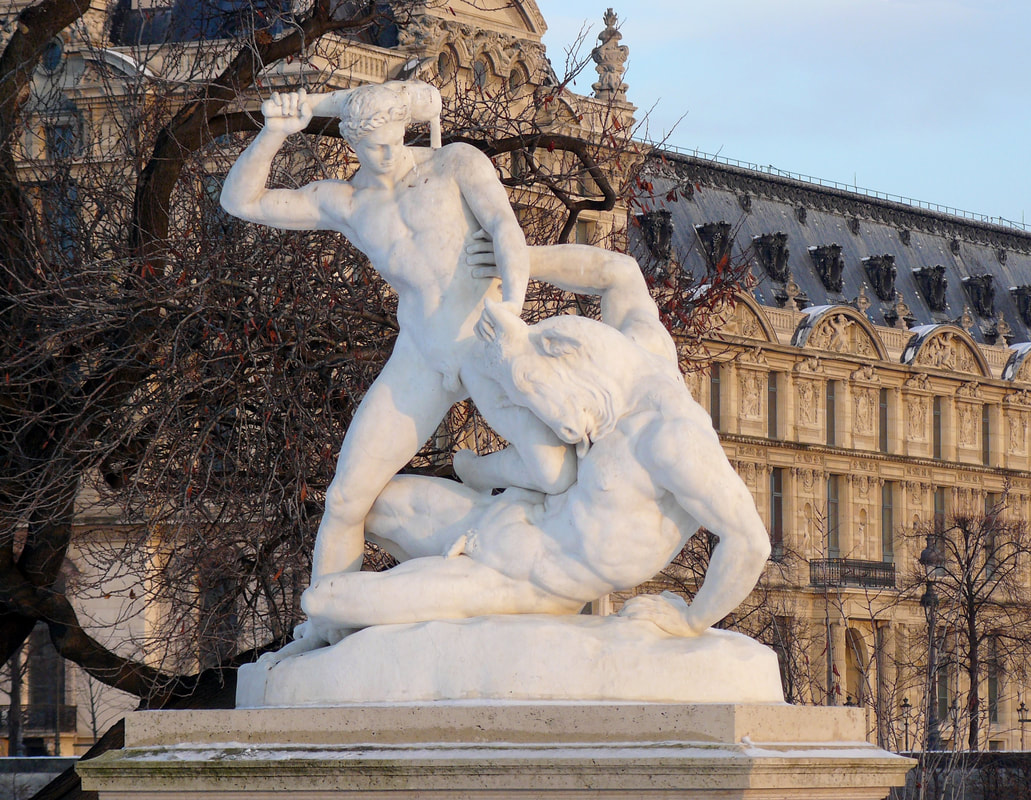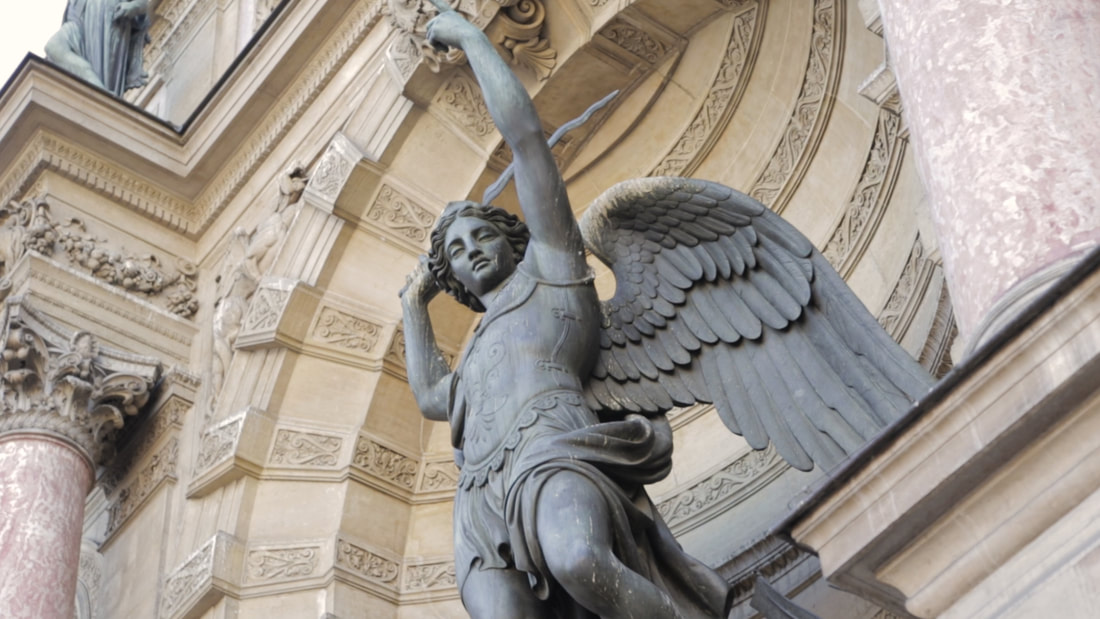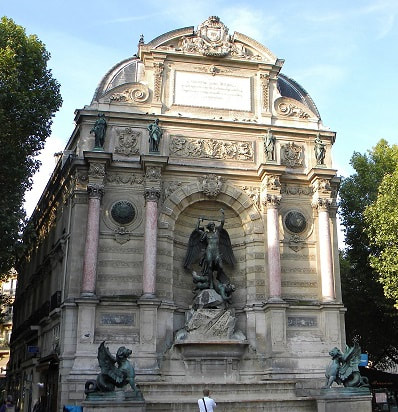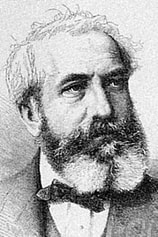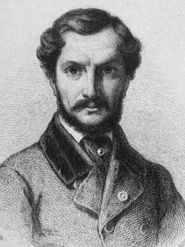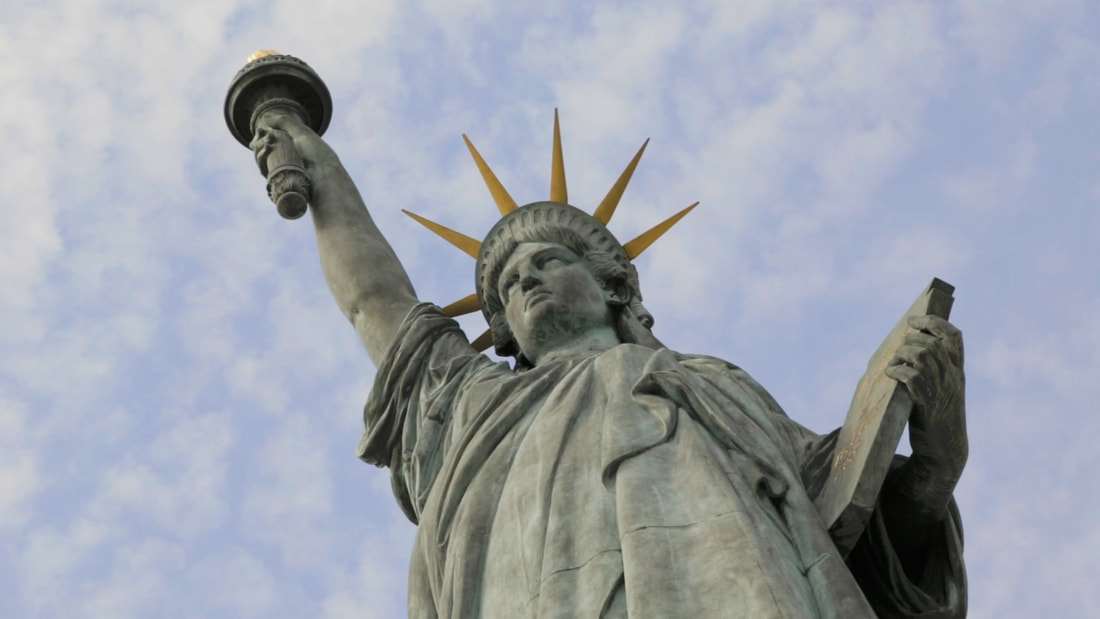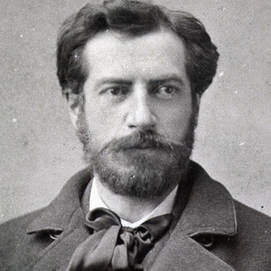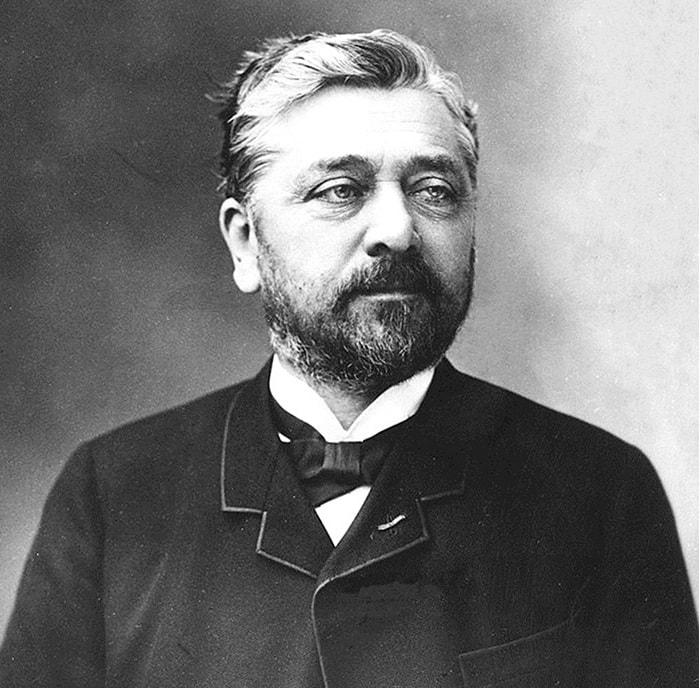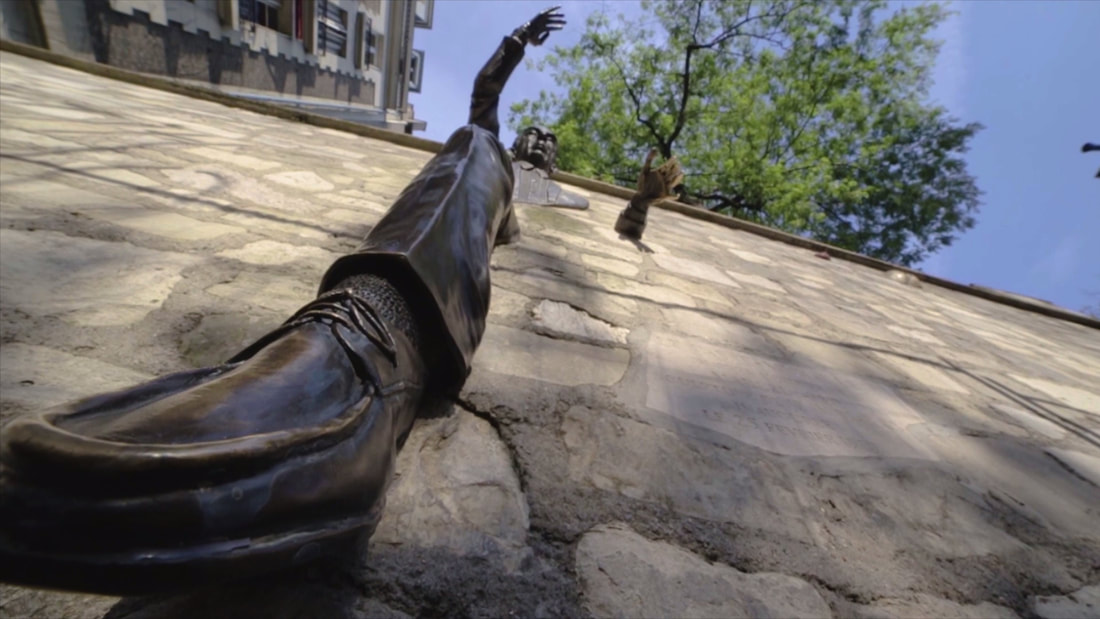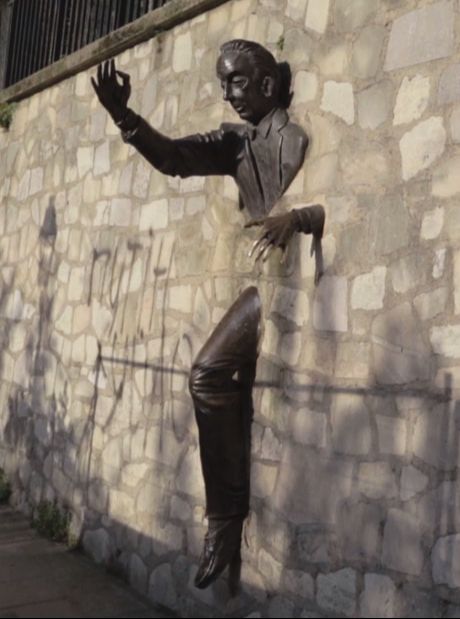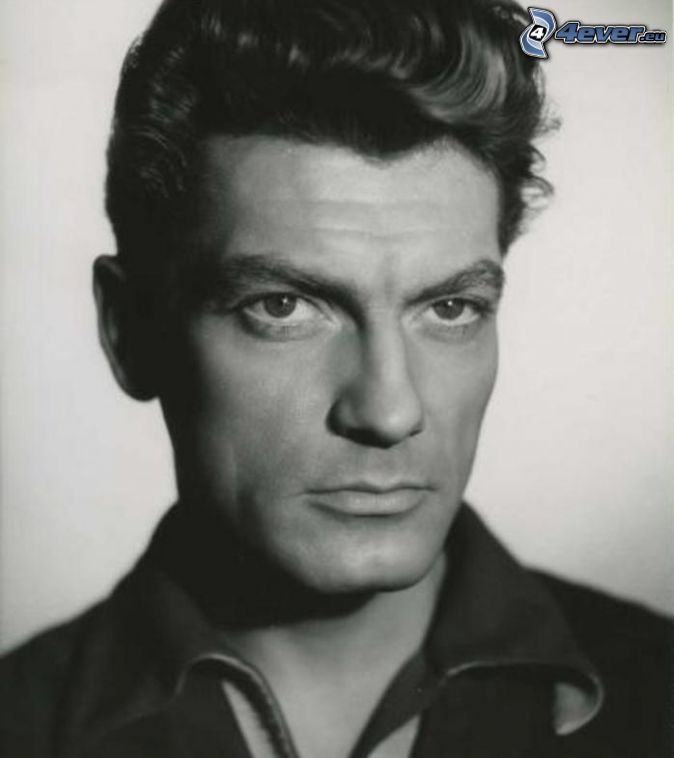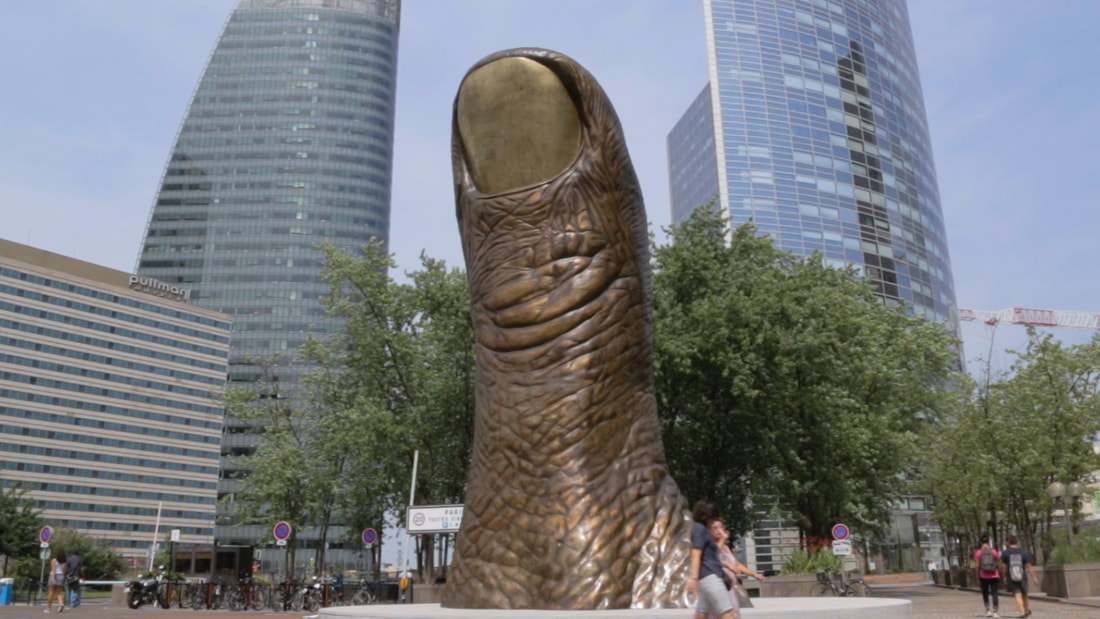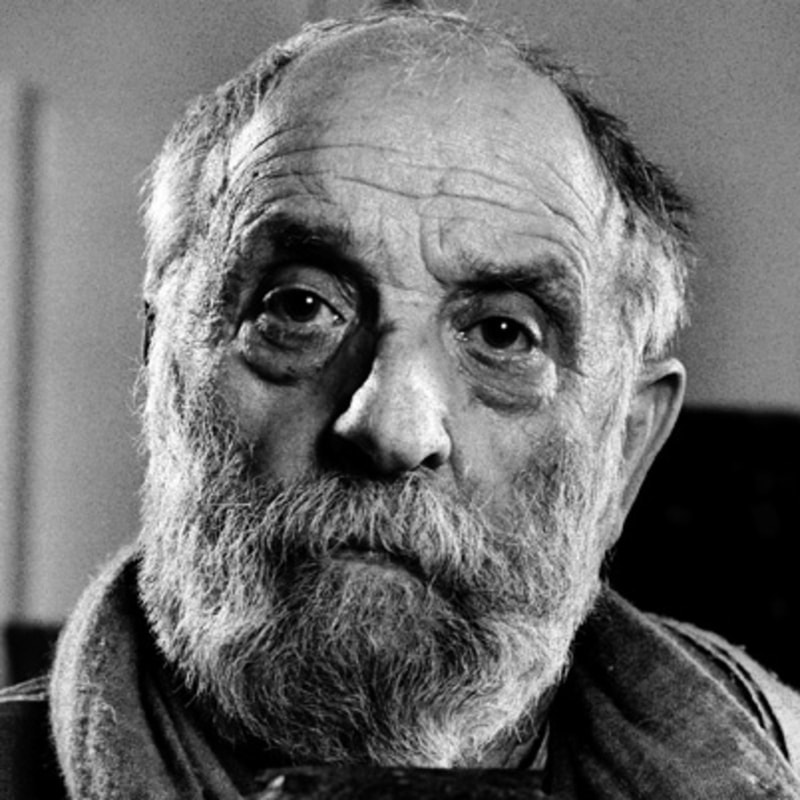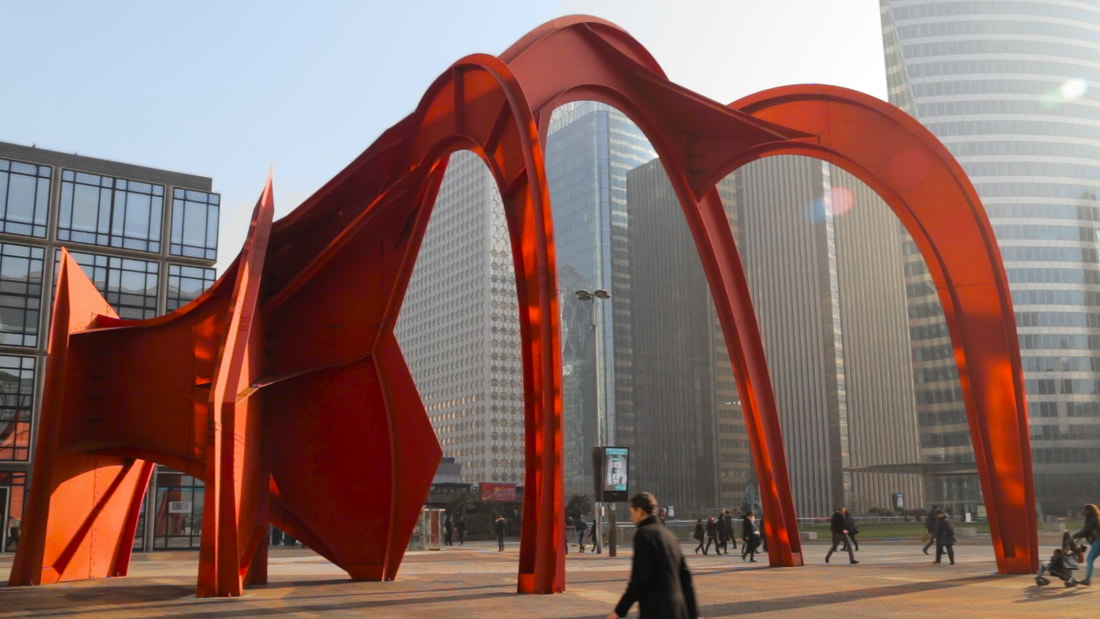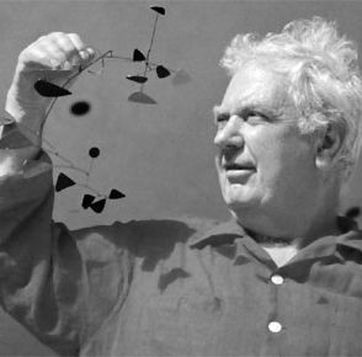Psi
Menu
PARIS
Below is a presentation of the artwork and locations in Paris,
in order of appearance in the film.
Below is a presentation of the artwork and locations in Paris,
in order of appearance in the film.
|
|
Doubles lignes indéterminées
Bernar Vénet
Bernar Vénet
"Doubles lignes indéterminées" (Two Indeterminate Lines) is a monumental, 12 by 10 meter, 16-ton steel art installation by French conceptual artist Bernar Venet. It is made of square tubes of painted steel which have been worked in such a way as to give the impression of solid bars which have been twisted, hammered and bent into shape. It was commissioned by EPAD (the public agency in charge of managing Paris' La Défense business district) at the end of the 1980s and installed in 1988.
|
Bernar Venet (born 1941) is a French conceptual artist who has exhibited his works in various locations around the world. In the 1960s he was close to the New Realists, including César and Arman. During his career, Venet experimented with randomness and many other painted steel works can be found in galleries, collections and parks throughout the world, including Nice, Strasbourg, Berlin and San Fransisco. In 2005, Venet received the title of Chevalier de La Legion d’Honneur, France’s highest honour.
1 place Costes et Bellonte, 92270 Bois-Colombes
|
Louvre Pyramid
I. M. Pei
I. M. Pei
The Louvre Pyramid (Pyramide du Louvre) is a large glass and metal pyramid designed by architect I.M. Pei, surrounded by three smaller pyramids, in the main courtyard (Cour Napoléon) of the Louvre Palace (Palais du Louvre) in Paris. The large pyramid serves as the main entrance to the Louvre Museum. Completed in 1989, it has become a landmark of the city of Paris. The structure, which was constructed entirely with glass segments and metal poles reaches a height of 21.6 meters (71 ft). Its square base has sides of 34 meters (112 ft) and a base surface area of 1,000 square meters (11,000 sq ft). It consists of 603 rhombus-shaped and 70 triangular glass segments.
|
Ieoh Ming Pei (1917-2019), commonly known as I. M. Pei, was a Chinese-American architect. Pei won a wide variety of prizes and awards in the field of architecture, including the AIA Gold Medal in 1979. In 1983, he won the Pritzker Prize, sometimes called the Nobel Prize of architecture.
¤Other works in Ψ: Inverted Pyramid in Paris
|
Musée du Louvre, 75001 Paris
|
Jardin de la Treille
G. Vexlard, L. Vacherot, J.-M. Albert
G. Vexlard, L. Vacherot, J.-M. Albert
The "Jardin de la Treille" is a vineyard themed garden which is part of the Parc de la Villette in Paris. It is one of several themed gardens within the park. In the summer, the vines grow on a canopy-like netting above the garden, creating a vegetation roof. It was designed by Gilles Vexlard in 1988 with elements by Jean-Max Albert and Laurence Vacherot.
|
|
Parc de la Villette, 75019 Paris
|
Les Coquelicots
Catherine Feff
Catherine Feff
|
"Les Coqueliquots" (meaning "The Poppies") is a 30-meter long, 3-meter high mural representing a field of poppies by French artist Catherine Feff. The wall borders an access ramp to the Coupole square in front of the Exaltis tower in Paris' business district of La Défense. Catherine Feff is a French artist whose studio is in Courbevoie. She has been working for over 30 years, making a name for herself in the field of trompe-l'oeil, installing massive canvases over buidlings under construction or being renovated.
Pl. Jean Millier, 92400 Courbevoie
|
La Fontaine des Quatre Parties du Monde
Jean-Baptiste Carpeaux
Jean-Baptiste Carpeaux
|
The "Fontaine des Quatre-Parties-du-Monde," which means "the fountain of the four parts of the world," is a monumental fountain by Jean-Baptiste Carpeaux dedicated in 1874 in the Marco Polo garden, at the southern end of the Luxemburg Gardens in the 6th arrondissement of Paris. Each part of the world is embodied by its female figures, representing Europe, Asia, Africa and America.
Jean-Baptiste Carpeaux (1827 – 1875) was a French sculptor and painter during the Second Empire under Napoleon III. The sculptor Eugène Legrain (1837–1915), a student of Carpeaux, was commissioned to make the sphere, and the sculptor Emmanuel Frémiet made the horses in the basin around the statue. |
Avenue de l'Observatoire, 75006, Paris
|
The Symbolic Globe
Erik Reitzel
Erik Reitzel
The Symbolic Globe is a monument by Erik Reitzel located in the main garden of the UNESCO headquarters in Paris, surrounded by the flags of all nations. Reitzel took inspiration from the old Greek word and tradition of symbolon, which means sign or token: when friends separated, the host would break an object and give a piece of it to each guest. When they met again, each one would bring his/her fragment and put the object back together again. This idea of sharing and friendship would then be perpetuated during the United Nations Summit in Copenhagen in 1950. The 10.000 delegates, originating from all the countries of the world, would each receive a symbolon enabling them to put together a lasting structure: the Symbolic Globe. The structure was then later moved to Paris and installed at the UNESCO headquarters in 1995.
|
Erik Reitzel (1941 - 2012) was a Danish civil engineer who for many years was a professor at the Royal Danish Academy of Fine Arts and at the Technical University of Denmark. He received several prizes for his research and work on architectural minimal structures, as well as for interesting and original solutions to major engineering projects. He was awarded the Légion d’honneur by the French president Mitterrand.
|
7 Place de Fontenoy,
75007 Paris |
Globe de l'Esplanade de l'Hôtel de Ville de Paris
|
The Hôtel de Ville in Paris, France, is Paris' City Hall, the building housing the city's local administration. It was completed in 1357. It serves multiple functions, housing the local government council, since 1977 the Mayor of Paris and her cabinet, and also serves as a venue for large receptions. The building stands on the Place de l'Hôtel-de-Ville – Esplanade de la Libération, a large open square, bordered by fountains, including globes on which greenery can grow. In the Middle-Ages, the square was called Place de la Grève and was used as a public meeting-place and also as a location where unemployed people gathered to seek work. This circumstance accounts for the current French expressions, être en grève (to be on strike) and faire (la) grève (to go on strike). Later, it became the site of most of the public executions in early Paris.
|
La Pyramide Inversée
Pei Cobb Freed & Partners
Pei Cobb Freed & Partners
"La Pyramide Inversée" (The Inverted Pyramid) is a skylight in the Carrousel du Louvre shopping mall in front of the Louvre Museum in France. It may be thought of as a smaller sibling of the more famous Louvre Pyramid, yet turned upside down: its upturned base is easily seen from outside. Directly below the tip of the downwards-pointing glass pyramid, a small stone pyramid (about 1 m, 3.3 ft) is stationed on the floor.
|
Dupleix Armillary Sphere
Alain le Boucher
Alain le Boucher
|
By the Dupleix Square in the 15th arrondissement of Paris is a large 4-meter-diameter armillary sphere that was made in 1991 by French sculptor Alain le Boucher. It has two rings: the meridian and the equator. The circles are graded on the inside: the equator measures time and the meridian has degrees. Unfortunately, the world axis that held planet Earth in the center of the sphere has disappeared. Alain le Boucher's work often centers around astronomy and the use of light.
|
Hollywood Sign
Le jardin d'acclimatation
Le jardin d'acclimatation
|
Le Jardin d'Acclimatation is a 19-hectare (47-acre) children's amusement park located in the northern part of the Bois de Boulogne in Paris. A popular destination for families and tourists, it has many different themed spaces, such as the Exploradrôme museum, the enchanted river ride and other attractions. A replica of the Hollywood Sign can be found along one of the paths in the park. The Hollywood Sign is a copyrighted sign managed by the Hollywood Sign Trust.
|
Twisted Lampost Star
Mark Handforth
Mark Handforth
"Twisted Lamppost Star" is a monumental sculpture by American artist Mark Handforth. It was installed along the eastern tramway line of Paris in 2012. The mast is twisted into a pentagram with the last line branching out into five smaller ones, each holding little lights.
|
Mark Handforth (born 1969) is an American sculptor. Often focusing on large-scale sculpture, Handforth’s work reflects objects from public spaces—street signs, fluorescent lights, street lamps, and traffic cones. These objects are then altered as Handforth twists and bends them, covers some with wax from burning candles or dripping paint. In 2003, he created "Lamppost," which was installed at the Doris Freedman Plaza in Midtown Manhattan, and was the first of many outdoor works in his series of twisted and bent lampposts.
|
Fragment of the Berlin Wall
|
After the fall of the Berlin wall in 1989, parts of the wall were auctioned off. In 1990, the city of Courbevoie and the public agency EPAD (managing the La Défense business district) bought a 3.2 meter fragment of the Berlin Wall and installed it 1996 outside La Couple gallery in La Défense. Other fragments of the wall can be found in public places around the world such as:
|
1 Rond-Point de la Défense, 92400 Courbevoie
|
(Placé) sur un point fixe, (Pris) depuis un point fixe n° 717
Lawrence Weiner
Lawrence Weiner
|
"(Placé) sur un point fixe (Pris) depuis un point fixe. no 717" (in English: (Put) on a Fixed Point (Taken) from a Fixed Point no 717) is a work by American conceptual artist Lawrence Weiner. It was made in 1992 and placed in the Tuileries Gardens in Paris in 2000. Lawrence Weiner (born 1942) is one of the central figures in the formation of conceptual art in the 1960s, and is regarded as a founding figure of Postminimalism's Conceptual art. For him, written words are the best form of presentation of his work. Weiner formulated his "Declaration of Intent" in 1968:
|
113 Rue de Rivoli, 75001 Paris
|
Homage to Sibelius
Eila Hiltunen
Eila Hiltunen
"Homage to Sibelius," by Finnish artist Eila Hiltunen, is a small-scale model of the Sibelius Monument by the same artist inaugurated in Helsinki (Finland) in 1967. As the last and definitive model, it is the one from which measurements were taken for the final work. It can be found in one of the interior patios of the UNESCO headquarters in Paris. Another smaller version stands on the grounds of the United Nations headquarters in New York City.
|
Eila Hiltunen (1922 – 2003) was a Finnish sculptor. Hiltunen studied sculpture at The Finnish Art Academy and twice won the top academic prize for sculpture before graduation. Her 1970s travels to the Middle East resulted in major public works in Teheran and Jeddah.
¤ Other works by Hiltunen in Ψ:
Sibelius Monument in Helsinki |
UNESCO
7 Place de Fontenoy 75007 Paris |
La Géode
Alain Fainsilber & Gérard Chamayou
Alain Fainsilber & Gérard Chamayou
La Géode is a mirror-finished geodesic dome located at the Science and Technology Museum (Cité des Sciences et de l'Industrie) - the largest science museum in Europe - in the Parc de la Villette, in the 19th arrondissement of Paris. It was designed by architect Adrien Fainsilber and engineer Gérard Chamayou. It is 36 metres (118 ft) in diameter, composed of 6,433 polished stainless steel equilateral triangles that form a sphere reflecting the sky. La Géode officially opened on May 6, 1985, and it holds within it an Omnimax theatre.
|
Adrien Fainsilber (born 1932) is a french architect and urban planner.
|
Gérard Chamayou (born 1929) is a french artist and engineeer.
|
26 Avenue Corentin Cariou, 75019 Paris
|
Sépharades
Pol Bury
Pol Bury
|
"Sépharades" are two fountains by Pol Bury installed since 1985 in the Cours d'Orléans courtyard within the Palais-Royal palace in Paris. They are each an conglomeration of stainless steel globes. Pol Bury (1922 – 2005) was a Belgian sculptor and painter. Among his most famous works is the fountain-sculpture L'Octagon, located in San Francisco. In 1985, Bury received Paris's National Grand Prize for Sculpture.
|
8 Rue de Montpensier, 75001 Paris
|
L'heure de tous
Arman
Arman
|
"L'heure de tous" (in English, The Hour of Everyone) is a sculpture by French artist Arman that is located in the Havre court (Court du Havre) in front of the St Lazare train station in Paris. It was made in 1985 and is a series of accumulated bronze clocks. Arman (1928 – 2005), whose full name was Armand Fernandez, was a French-born American artist. He moved from using objects for the ink or paint traces they leave ("cachet", "allures d'objet") to using them as the painting itself. He is best known for his "accumulations" and destruction/recomposition of objects.
¤ Other Arman artwork in Ψ: La Vénus des Arts in Paris |
4 Rue d'Amsterdam,
75009 Paris |
Le jardin des mirois
Bernard Tschumi
Bernard Tschumi
|
Parc de la Villette, 75019 Paris
|
La Vénus des Arts
Arman
Arman
"La Vénus des Arts" (the Venus of the Arts) is a bronze sculpture by French artist Arman made in 1992 and established close to the Beaux-Arts of Paris. It is illustration of art in all its forms, represented by an assembly of various slices of a feminine body with elements of different arts: a cello, a painting frame and books. Her face is the result of interlacing two different faces: the Venus de Milo and a Benin bronze, mixing thereby traditional African and modern European facial archetypes.
|
Arman (1928 – 2005), whose full name was Armand Fernandez, was a French-born American artist. He moved from using objects for the ink or paint traces they leave ("cachet", "allures d'objet") to using them as the painting itself. He is best known for his "accumulations" and destruction/recomposition of objects.
¤ Other Arman artwork in Ψ: L'heure de tous in Paris |
10 rue Jacques-Callot,
75006 Paris |
Point Growth
Lim Dong-Lak
Lim Dong-Lak
|
"Point Growth" is a stainless steel & bronze sculpture by Lim Dong-Lak, created in 1999 as part of his Poetic Totem series, and donated to La Défense in 2006 for the 120th anniversary of the treaty of friendship and commerce between France and South Korea. It represents a young tree growing out of a globe. Lim Dong-Lak (born 1954) is a South Korean sculptor. His view of the world is marked by Taoism, questioning of the natural order of things, looking for the universe beyond human perception.
|
1 Place de la Pyramide,
92911 Paris La Défense |
Thésée Combattant le Minautore
Jules Ramey
Jules Ramey
|
"Thésée Combattant le Minautore" (Theseus fighting the Minotaure) is a marble sculpture located in the Tuileries Gardens (Jardins des Tuileries) in front of the Louvre palace. It was made by French sculptor Jules Ramey (1796 - 1852) between 1821 and 1827 and placed in the gardens in 1832. It represents Greek mythical king Theseus battling with the Minotaur, a mythical creature with the head of a bull and the body of a man that dwelt at the center of a labyrinth.
113 Rue de Rivoli, 75001 Paris
|
La Fontaine St-Michel
G. Davioud & F. Duret
G. Davioud & F. Duret
|
The Saint-Michel fountain is a monumental fountain located in Place Saint-Michel in the 5th arrondissement in Paris. It was constructed in 1858–1860 during the French Second Empire by architect Gabriel Davioud. It was part of the great project for the reconstruction of Paris overseen by Baron Haussmann: in 1855, Haussmann completed an enormous new boulevard, originally called boulevard de Sébastopol-Rive-Gauche, now called Boulevard Saint-Michel, which opened up the small place at Pont-Saint-Michel into a much larger space. In 1858, Davioud proposed that the central figure be the Archangel Michael wrestling with the devil. The figure of Saint Michael and the devil was made by Francisque-Joseph Duret.
|
|
Gabriel Davioud (1824 –1881) was a French architect. As a colleague of the urban planner Baron Haussmann, he designed much of the characteristic Parisian street furniture: benches, pavilions, bandstands, fountains, lampposts, signposts, fences and balustrades, jetties, monuments, as well as a number of landmark buildings. Francisque Joseph Duret (1804 –1865) was a French sculptor. He received the medal of honor in 1855, was an Officer in the Legion of Honor, and was made a member of the Institut de France.
33 Glasshouse St, Soho, London W1B 5RD, UK
|
The Statue of Liberty Replica
F. A. Bartholdi & G. Eiffel
F. A. Bartholdi & G. Eiffel
A 22-meter quarter scale replica of the famous Statue of Liberty (really called Liberty Enlightening the World, La Liberté éclairant le monde) stands at the southern tip of the Cygnes island of Paris. The original Statue of Liberty, dedicated on October 28, 1886, was a gift from the people of France to the people of the United States, designed by French sculptor Frédéric Auguste Bartholdi and built by Gustave Eiffel. The statue is a figure of a robed woman representing Libertas, a Roman godess. She holds a torch above her head and in her left arm carries a tabula ansata inscribed in Roman numerals with "JULY IV MDCCLXXVI" (July 4, 1776), the date of the U.S. Declaration of Independence. A broken chain lies at her feet. The statue became an icon of freedom and of the United States, and was a welcoming sight to immigrants arriving from abroad. The replica in Paris was inaugurated by President Carnot on July 4, 1889, only three years after its US counterpart, and was given to the city of Paris by the Parisian community in America to mark the centennial of the French Revolution. The tablet in her left hand bears the inscription IV Juillet 1776 = XIV Juillet 1789, recognizing the American Independence Day and the French Bastille Day.
Le Passe-Muraille
Jean Marais
Jean Marais
"Le Passe-Muraille," translated as The passer-through-walls or The Man Who Walked Through Walls, is a bronze statue located in the Montmartre area of Paris, representing a man half-trapped in a stone wall. It was created in 1989 by French actor and sculptor Jean Marais in order to pay tribute to Marcel Aymé (1902-1967), a popular French novelist, screenwriter and playwright. Le Passe-Muraille is the hero of one of Marcel Aymé’s novels: his real name, Mr. Dutilleul, was a modest clerk working in an obscure ministry department who discovered one day that he could walk through walls.
Le Pouce
César Baldaccini
César Baldaccini
"Le Pouce" (The Thumb) is a 12-meter high, 18-ton monumental bronze mold of artist César Baldaccini's thumb. César made the first cast of his thumb in 1965 for a Parisian art gallery; it was 40cm high and in pink translucent plastic. The huge success of this original work encouraged César to reproduce his thumb in different sizes, colors and materials (others can be found around the world in Marseille, Koblenz, Seoul, etc.). This larger version was commissioned by EPAD (the public organization managing the business district of La Défense) and unveiled on June 16, 1994.
|
César created this sculpture from an enlarged molding of his own thumb using the 3-D pantographic technique. The pantorgaph is an instrument that can reproduce volumes at any scale while maintaining the proportions between the original and its copy. As such, the enlargement of the fingerprints and skin details are anatomically accurate.
César Baldaccini (1921 – 1998) was a noted French sculptor. He was at the forefront of the Nouveau Réalisme movement with his radical compressions (compacted automobiles, discarded metal, or rubbish), expansions (polyurethane foam sculptures), and fantastic representations of animals and insects. |
Place Carpeaux, 92800 Puteaux
|
L'araignée rouge
Alexander Calder
Alexander Calder
"L’Araignée Rouge," which is French for The Red Spider, is a monumental sculpture by Alexander Calder in the business district of La Défense and erected in 1976 (the year of Calder's death). It was commissioned in 1974 by EPAD as part of its strategy to host public artwork from major international artists. The Red Spider is 15 meters high, 25 meters long and weighs more than 60 tons. It is composed of six vertical panels which were assembled on site, the bolts being designed by Calder himself. Like many of Calder's works, it was manufactured by Etablissements Biemont in Tours. The artist supervised all stages of production and installation, chosing also the location where it would be installed. It was renovated in 2017.
|
Alexander Calder (1898 –1976) was an American sculptor known as the originator of the mobile, a type of moving sculpture made with delicately balanced or suspended shapes that move in response to touch or air currents. Calder’s monumental stationary sculptures, such as the Red Spider, are called stabiles. In 1987, the Calder Foundation was established by Calder's family. The foundation "is dedicated to collecting, exhibiting, preserving, and interpreting the art and archives of Alexander Calder and is charged with an unmatched collection of his works."
¤ Other Calder works in Ψ: "Four Arches" in Los Angeles & "Homage to Jerusalem" in Jerusalem |
7 Place de la Défense, 92974 Paris La Defense
|
[email protected]
© COPYRIGHT 2022. ALL RIGHTS RESERVED.
© COPYRIGHT 2022. ALL RIGHTS RESERVED.
